
Click the link of a sound once to play the sound. Click the link to the sound again to pause it. Right click on a link to save it to your computer.

TOS Warp Core
- View history
Richard Merk said, on Saturday, 23, January, 2010:
> I had no problem with there not being a warp core in engineering because the TOS Enterprise didn’t have one either.
Wait. She didn't? Are you sure? Now, I think it's safe to say that the name "Warp Core" did not appear in TOS. However - I think this topic bears some discussion
So I'll Discuss. Please Feel Free to add your input below.
- 1 Right. What's a Warp Core?
- 2 The First Unambiguous Warp Core
- 3 The Mature Warp Core
- 4 Dilithium
- 5 The Elaan of Troyius
- 6 The Big Question
- 7 That would mean
- 8 That Which Survives
- 9 Evil Kirk, Ben Finney and Khan Noonian Singh
- 10 Oh. That's why!
- 11 A Last Note For Safety
Right. What's a Warp Core? [ ]
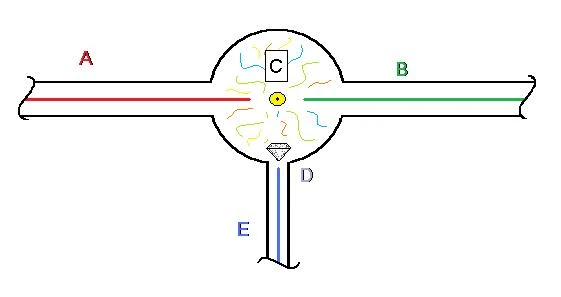
Warp Core Metaphor
I like to use Steam Engines as the Metaphor for Star Trek Warp Drives.
In this metaphor, the Warp Core is the Boiler.
- A - Anti-Matter comes in here
- B - Matter comes in here
- C - They Meet Inside with a Tremendous FWACKOOM!
- D - The FWACKOOM! Meets the Dilithium Crystal and some weird techno-magic happens
- E - Energized Plasma comes out and is channeled to do work.
This is also a map for how the Warp Core looks.
The First Unambiguous Warp Core [ ]
The First Unambiguous Warp Core is in Star Trek: The Motion Picture.
Although Part C - the FWACKOOM! Chamber is subtle - the glowing lights and plasma conduits make it plain, especially in light of subsequent development of the franchise.
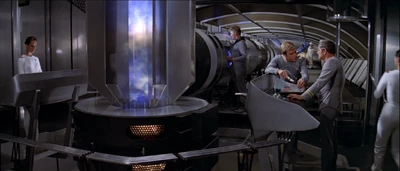
Decker and Scotty discuss the spacing of the spark plugs.
The Mature Warp Core [ ]
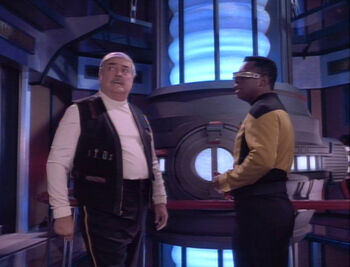
Montgomery Scott, Geordie LaForge, FWACKOOM name unknown
By 1987, 9 years later, the fictional metaphor is pretty well set.
This is the TNG Warp Core. Note the FWACKOOM Chamber right behind Scotty and Geordie.
Dilithium [ ]
Dilithium magics up the FWACKOOM reaction, turning it into useful energy.
Here we see Scotty fussing with the Dilithium on the Enterprise-D
The Dilithium must be tended carefully. A mistake there can let the FWACKOOM escape. This is very bad. Unless you like buying new starships. And new crews to man them.
The Elaan of Troyius [ ]
In The Elaan of Troyius, we see Kryton, the leader of the Dohlman's body guard sabotage the Enterprise's Engines.
Although I have to say I am not sure I'd blame him. He is, in fact, dressed like a tacky lamp.
He puts a bomb in the Dilithium crystal dealie.
The Big Question [ ]
So here's my question - Are these two things the same part, roughly?
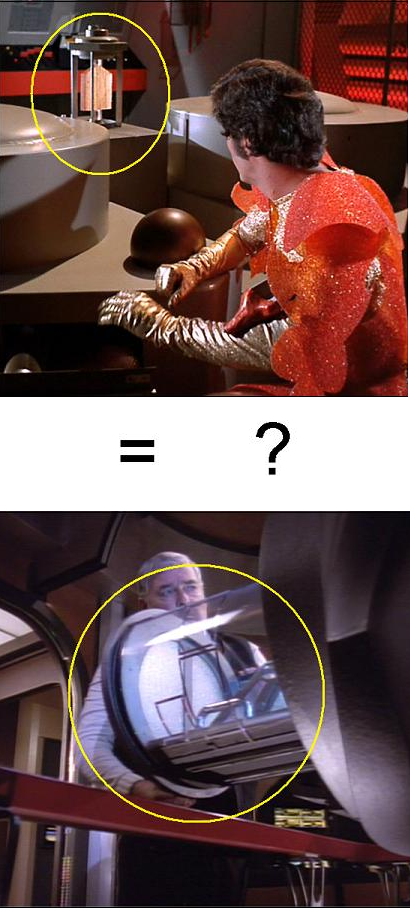
Are these similar thingees?
Because in ST-OM I have assumed that the Answer is "Yes". Both are frame that holds the Dilithium in the right place to perform it's function of processing the FWACKOOM into useful energy.
That would mean [ ]
That would mean that this object maps out roughly to the Warp Core.
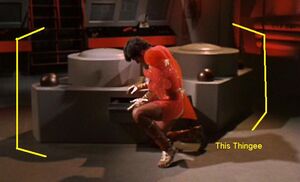
But, y'know, without Kryton, the party lamp
Or at least it maps out to the facing surface of the Enterprise-D Warp core. If the TNG Warp Core were laid flat on it's back, sunk below deck level and built by Newport News Shipyards.
You have to allow some windage here. The metaphor was simply not as clear or as well developed in TOS.
That Which Survives [ ]
In "That Which Survives" , A Holographic Lee Merriweather transports the Enterprise over 1000 light years away.
In ST-OM this would have sucked pretty badly for Kirk, McCoy, Sulu and Ensign Ricky. Getting back to pick them up would have taken a season and a half in ST-OM.
But the Enterprise has a worse problem than that. Scotty says - "The emergency bypass control of the matter/antimatter integrator is fused."
Parsing it out, the Throttle is jammed open. The Warp Drives are being handed all the fuel they can handle and then some. The Enterprise screams through space - but boiler pressure is building. In minutes the boiler will over pressure and explode.
This maps out to the Steam Boiler analogy pretty well.
But there are other episodes where things don't map that well.
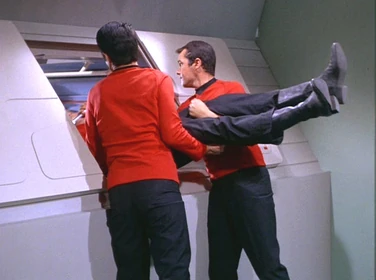
The emergency bypass control of the matter-antimatter integrator is positioned for easy access and maintenance.
Evil Kirk, Ben Finney and Khan Noonian Singh [ ]
The Object I pointed out there does not consistently occur in TOS. Blatant examples of it NOT being there are in the TOS Episodes "Enemy Within", "Court Martial" and Space Seed . In these, Engineering turns into the Squared Circle . Finney, Kirk and Khan Settling things with their fists.
Spock just slides up behind Evil Kirk and neck pinches him. Logical. No need to lose your cool about it.
During all of these, this proposed Proto-Warp-Core Object is notable for not being there.
I was flummoxed for a while.
Not much of a warp core if it doesn't show up for work half the time, is it?
The object I am pointing at appears in the Constellation's Main Engineering Compartment during The Doomsday Machine . They didn't just hack it together for The Elaan of Troyius .
Oh. That's why! [ ]
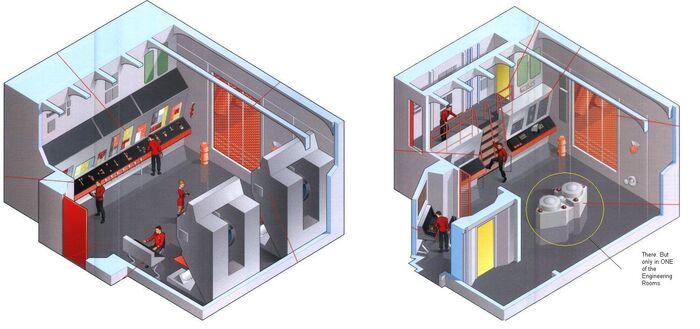
It's a Big Ship
The TOS Enterprise Has two engineering rooms.
That explains everything. One is for one set of thingees, the other one is for the other set of thingees.
One sits at the rear of the Primary Hull with the Impulse Drives (Where we always thought it was) . The other one sits nestled in the Secondary Hull, where the Movies place it.
It's a neat answer. I like it.
A Last Note For Safety [ ]
Do not let the FWACKOOM escape your warp core. It never ends well.
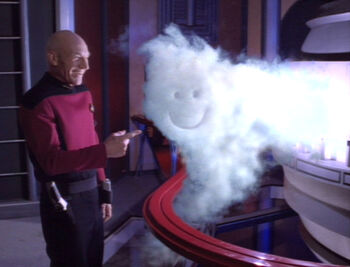
Ensign Ricky clearly is not taking this seriously.
Jayphailey 06:41, January 24, 2010 (UTC)
- 1 List of Constitution Class Starships
- 2 Ferengi Trade Ships
- More to Explore
- Series & Movies
Star Trek: Prodigy Explained - Warp Core
What is a warp core?
Spoilers for season one, episode eight of Star Trek: Prodigy to follow!
Star Trek: Prodigy 's Angus Imrie ( Zero ) explains warp cores and warp drive .
Star Trek: Prodigy Season 1 is available to stream on Netflix outside of markets including Canada where it is available on CTV.ca and the CTV App, France on France Televisions channels and Okoo, in Iceland on Sjonvarp Simans Premium, as well as on SkyShowtime in the Nordics, the Netherlands, Portugal, Spain, and Central and Eastern Europe. Star Trek: Prodigy is distributed by Paramount Global Content Distribution.
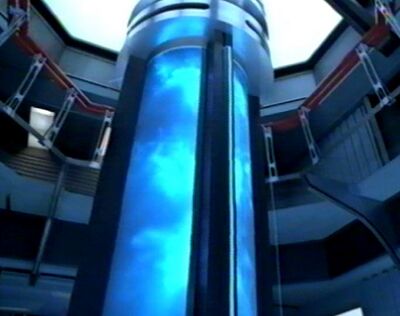
There are so many vital components that comprise a Warp Drive System that it is hard to know where to start. So let's start with the basics:
There are two distinct fuel storage systems on board any starship; the matter storage is generally a single large fuel tank holding a large amount of slush Deuterium- in the case of the Galaxy Class there is 62,500 m3 of actual Deuterium within 63,200 m3 of tankage space - the rest being accounted for by internal compartmentalisation of the fuel tank. The ship thus carries 12,500 metric tons of fuel, sufficient for a mission period of three years assuming normal use of warp and impulse drive, orbiting of planets, etc.
The antimatter is contained within much smaller pods; the standard starship antimatter pod is capable of holding 100 m3 of fuel for a total of 3,000 m3 in a Galaxy class Starship. Starfleet is somewhat reticent about revealing exactly how much antimatter is kept on board its starships, as this would allow threat forces to make detailed estimates of the total output of a ships power systems. It is known that the antimatter used in the Galaxy class is antihydrogen, and that it is kept stored within magnetic fields. In the event of a systems failure which threatens antimatter containment, the pods can be thrown clear of the ship by emergency systems of considerable reliability.
Fuel from the pods is sent to the reactant injectors; these are designed to condition and feed streams of matter and antimatter into the warp core. The matter reactant injector is located at the top of the warp core; it is a conical structure some 5.2 metres in diameter and 6.3 metres high. The injector is constructed of dispersion strengthened woznium carbmolybdenide. Shock attenuation cylinders connect it to the deuterium fuel tank and the skeletal structure of the ship, allowing it to 'float' free within the structure.
Within Starfleet vessels, the MRI contains redundant sets of crossfed injectors. Each injector would consists of a twin deuterium manifold, fuel conditioner, fusion pre-burner, magnetic quench block, transfer duct/gas combiner, nozzle head, and related control hardware. other designs are in use by civilian craft and other species. Although operation varies from class to class, in general slush deuterium enters the inlet manifolds and is passed to the conditioners where heat is removed. This brings the deuterium to just above solid transition point; micropellets are formed and then pre-burned by a magnetic pinch fusion system. The fuel is them sent on to a gas combiner where it reaches a temperature in the region of 106 K. Nozzle heads then focus the gas streams and send them down into the constriction segments.
Starfleet safety protocols require that should any nozzle fail, the combiner can continue to supply the remaining nozzles which would dialate to accomodate the increased fuel flow. The present generation of nozzles are constructed of frumium-copper-yttrium 2343.
The antimatter injector lies at the lower end of the warp core. Its internal design is distincly different from that of the matter injector owing to the dangerous nature of antimatter fuel; every step in manipulating the antihydrogen must use magnetic to keep the material from Physically touching any part of the structure. In some ways the ARI is a simpler device requiring fewer moving components. It uses the same basic structural housing and shock attenuation as the matter system, with adaptions for magnetic suspension fuel tunnels. The structure contains three pulsed antimatter gas flow separators; these serve to break up the incoming antihydrogen into small managable packets and send them up into the constriction segments. Each flow separator leads to an injector nozzle and each nozzle cycles open in response to computer control signals. Nozzle firing can follow highly complicated sequences resulting from the varying demands of reaction pressures and temperatures and desired power output, amongst other factors.
The magnetic constrictors make up the bulk of the warp core. They provide Physical support to the reaction chamber, pressure containment for the whole core and, most importantly, guide and align the fuel flow onto the desired location within the reaction chamber.
The matter constrictor is typically longer than the antimatter constrictor, as antimatter is easier to focus and so requires a shorter distance for the same accuracy. Typically, the magnetic constrictors are divided into segments; each segment will contain several sets of tension frame members, a toroidal pressure vessel wall, several sets of magnetic constrictor coils and related power and control hardware. Constrictor coils will have dozens of active elements, and on more advanced designs these will be configures to contain the magnetic field almost wholly within the constrictor, with minimum spillage into the exterior environment. Starfleet warp cores usually have the outermost layers of the constrictors constructed of a semi-transparent layer which allows harmless secondary photons to escape from the inner layers, creating a glow effect. This gives an immediate visual cue to the current activity rates within the warp core.
As the fuel is released from the injector nozzles, the constrictors compress it and increase the velocity considerably. This ensures the proper collision energy and alignment within the reaction chamber.
This is in many ways the "heart" of the ship. The principle function of any reaction chamber is to allow the matter and antimatter streams to come together and direct the resultant energy flow into the power transfer conduits. This apparently simple task is rendered highly complex by the need to allow the various sensor and other monitoring and control equipment to function within the chamber. The addition of dilithium to regulate and control the reaction, while allowing far higher efficiency and so increasing the power output, has also lead to ever more complex designs - most especially in more recent starships which are designed to allow continual recompositing of the dilithium whilst in use. Nevertheless, reaction chambers of today perform fundamentally the same task as those of a century ago or more.
The power transfer conduits are similar in nature to the magnetic constrictors of the warp core, in that they are ducts designed to use high energy magnetic fields to carry energetic plasma from one point to another. But where the magnetic constrictors operate only across relatively short distances and require a very high degree of precision with a comparitively low energy plasma, the PTC's must carry very energetic plasma across large distances with - relatively speaking - far less finesse.
Federation starships are equipped with a separate PTC line for each nacelle, a measure which increases resistance to battle damage or other failures. Since most Starships have twin nacelles, two PTC's will typically be arranged to be symmetrical about the ships centreline. These will proceed through the bulk of the engineering hull and along the connecting struts, if any, to the nacelles themselves.
Smaller versions of these heavy duty systems are also used to carry power to components such as the phasers, shields, and high energy scientific laboratories.
At the terminus of the Power Transfer Conduits are the plasma injectors. One of these devices is fitted in each nacelle, and has the task of sending a precisely aimed plasma flow through the centre of the warp coils.
Because of the relatively low accuracy with which the plasma flow is usually controlled by a PTC, the plasma injector system must often be designed to re-condition the fuel flow in order to dampen down turbulence and so ensure a smooth flow through the warp coils. In many Starfleet designs, most especially those systems with the highest raw power output, the plasma flow from the PTC is split into two parts and sent through swirl dampers before being recombined during the injection process. Long experience has found that this method reduces the size of the required hardware to a reasonable minimum.
- 1 Antimatter containment
- 2 Antimatter Inducer
- 3 Antimatter Relay
- 4 Deuterium Cartridge
- 5 Electro-plasma
- 6 Emergency Shutdown Trip
- 7 Main Stage Flux Chiller
- 8 Magnetic interlock
- 9.1 Bussard collector
- 9.2 Plasma injector
- 9.3 Warp coil
- 10 Nullifier core
- 11 Pre-Stage Flux Chiller
- 12 Phase inducer
- 13.1 Types of Plasma Conduit
- 14.1 Plasma coolant
- 15 Plasma regulator
- 16 Power transfer conduit
- 17 Power Transfer Grid
- 18 Space Matrix Restoration Coil
- 19.1 Matter-Antimatter Reaction Assembly
- 19.2 Antimatter Injector
- 19.3 Dilithium Crystal Chamber
- 19.4 Dilithium Chamber Hatch
- 19.5 Dilithium Crystal
- 19.6 Dilithium Articulation Frame
- 20 Matter Injector/Deuterium injector
- 21 Theta-matrix Compositor
Antimatter containment [ edit ]
Antimatter containment is the process whereby antimatter and matter are kept separated by the use of magnetic fields to prevent the oppositely charged particles from colliding, which would result in the mutual destruction of the matter and antimatter, along with a violent and explosive release of energy.
Antimatter containment is a key function of a starship warp core which uses both antimatter and matter, released in controlled and balanced amounts, to provide energy which powers the ship's warp drive.
Galaxy-class starships in the 24th century had a system of seven independent computer safety locks to prevent antimatter containment from being breached (TNG: "Contagion"), assuming that there was no damage to the warp core components.
If the antimatter containment field strength drops below 15% on a Galaxy-class starship the field will collapse, destroying the ship. (TNG: "Disaster")
In 2366 the non-corporeal Koinonians drained antimatter from the antimatter pods to use it as energy to create their replica of Marla Aster. This was stopped by increasing the shield harmonics to match the antimatter containment effectively severing the Koinonian beam. (TNG: "The Bonding")
After Wesley Crusher experimented with a static warp bubble in main engineering in early 2367 and a flash of light was registered, Geordi La Forge ran a level-2 diagnostic of the antimatter containment and warp drive to make sure that none of the systems were affected by the experiment. (TNG: "Remember Me")
Antimatter Inducer [ edit ]
Antimatter inducers are warp drive components associated with a starships consumption of fuel. The principal behind the component is that the more efficient the inducer is, the less fuel is consumed during warp flight. (ENT: "Twilight")
In an alternate timeline, Jonathan Archer came up with a way to upgrade the antimatter inducers. Upgrades based on his specs were described as "working nicely." (ENT: "Twilight")
Montgomery Scott initially had difficulty locating the "damned" antimatter inducer on the Klingon Bird-of-Prey they managed to hijack from Commander Kruge. With Pavel Chekov's assistance, Scott pressed the necessary button to activate the inducer which quickly brought the ship up to full power. (Star Trek III: The Search for Spock)
Antimatter Relay [ edit ]
The antimatter relay is a component of the Enterprise's warp drive lined with a platinum-cobalt alloy. Commander Charles Tucker and five of his men had to strip over two hundred relays to obtain a half-liter of platinum to pay a trellium mine overseer with for the privilege of visiting Kessick. (ENT: "The Xindi")
Deuterium Cartridge [ edit ]
The deuterium cartridges are components of a starship's warp drive system, presumably relating to the deuterium fuel source.
In 2370, Lieutenant Commander Geordi La Forge asked Ensign Tyler to help Farrell inspect the deuterium cartridges shortly before a new warp core was to be activated aboard the USS Enterprise-D. (TNG: "Phantasms")
Electro-plasma [ edit ]
In high-power mechanics, electro-plasma (also known as warp plasma or drive plasma) is a super-energized plasma used to transfer energy from a central power source using plasma conduit transfer. In matter/antimatter reactions, dilithium controls the amount of power generated in the reaction chamber, which produces a steady stream of plasma. On Federation starships and outposts, as well as those of other major spacefaring species, electro-plasma is the main power transfer medium.
A Federation EPS (electro-plasma system) feeds from a warp core on a starship, a fusion reactor on an installation or starbase, or an impulse reactor on a non-warp spacecraft. Besides the large warp plasma conduits (power transfer conduits), there are smaller plasma conduits, with EPS taps that transfer power as electricity to all subsystems connected to the power transfer grid. If a plasma conduit or EPS tap ruptures, the contents could set off a plasma fire. (ENT: "The Forgotten"; TNG: "Disaster")
Energized electro-plasma may be stored in plasma canisters or plasma infusers for mobile use, and is used in plasma torches and plasma weapons (such as plasma cannons, plasma charges, plasma waves, plasma rifles and plasma torpedoes). It may also be naturally-generated, such as the energetic anomalies found in plasma storms and fields. (DS9: "The Maquis, Part I"; VOY: "Caretaker")
Emergency Shutdown Trip [ edit ]
Emergency shutdown trips are part of the safety systems of a starship's warp drive. (Star Trek: The Motion Picture)
Main Stage Flux Chiller [ edit ]
Main stage flux chiller refers to part of a starship's warp drive. The USS Enterprise after its refit of 2271 had port and starboard main stage flux chillers. (Star Trek: The Motion Picture)
Magnetic interlock [ edit ]
Magnetic interlocks form part of the warp drive system aboard starships, as part of the warp core assembly. Magnetic interlocks can be disrupted by subspace vacuoles. (VOY: "Emanations")
During the battle with the Duras sisters in 2371, the starboard interlock of the USS Enterprise-D took damage, and required reinforcement. Subsequently, the interlocks ruptured, leading to a coolant leak, and eventually a warp core breach that destroyed the secondary hull. (Star Trek Generations)
Following sabotage by the True Way to the USS Orinco, the magnetic interlocks on the runabout failed, leading to a warp core breach. (DS9: "Our Man Bashir")
Nacelle and Nacelle Sub Components [ edit ]
A nacelle is an outboard engine housing structure on spacecraft.
Impulse nacelles of a sublight shuttlecraft house the ships impulse driver engines. (TNG: "In Theory", "Descent" display graphic) The warp nacelles in warp-capable shuttles and starships house the warp coils, necessary components of warp drive. The warp coils create a subspace displacement field, which "warps" the space around the vessel allowing it to "ride" on a spatial distortion, and travel faster than the speed of light. (ENT: "Cold Front") While not always present on starships, warp nacelles are the most common component of warp flight, dating as far back as Zefram Cochrane's original warp ship, the Phoenix, circa 2063. They were also sometimes known as "power nacelles" in the 23rd century. (Star Trek: First Contact; TOS: "The Doomsday Machine") Aboard Federation vessels of the 24th century, warp coils are fed by plasma conduits from the warp core reactor assembly. Nacelles are usually separated from the main structure of the ship because of radiation generated by the nacelles; when at optimal levels, the radiation could be deleterious to the safety of ship and crew. (citation needed • edit) Nacelles are separated from the ship by large pylons, and usually house a Bussard ramscoop at the fore end, primarily used for collecting hydrogen from space.
A nacelle's interior also includes a small control room, accessible in nominal conditions by a Jefferies tube that permits maintenance and monitoring of the system's operation. (TNG: "Eye of the Beholder") Aboard the prototypical NX class Enterprise of the 22nd century, a long catwalk spanned the length of each nacelle and, in emergency situations, acted as shelter for the ship's crew against certain types of radiation such as that created by neutronic storms. (ENT: "The Catwalk", "The Crossing")
Most vessels typically have two nacelles. However, vessels can operate with one nacelle disabled, but at reduced warp speeds. (VOY: "Year of Hell", ENT: "Twilight") It is not unprecedented, though, for vessels to have different nacelle configurationss. For example, Federation Freedom-class starships have one, Niagara-class starships have three, Constellation-class and Prometheus-class starships have four nacelles. (TNG: "The Battle", "The Best of Both Worlds, Part II", VOY: "Message in a Bottle")
Even at sublight speeds serious impacts from weapons or other objects can spell disaster for a ship because of a feedback of energy throughout the vessel. The Enterprise-D was destroyed by such an impact in an alternate timeline when the USS Bozeman collided with one of Enterprise's warp nacelles. (TNG: "Cause and Effect")
Some starship classes, such as the Defiant-class and the Steamrunner-class, possess nacelles that are integrated into the ship's main structure without pylons. (Star Trek: Deep Space Nine; Star Trek: First Contact)
In 2377, the expression "third nacelle" was analogous to "fifth wheel". (VOY: "Inside Man")
Bussard collector [ edit ]
The Bussard collector, also known as a Bussard ramscoop or ramscoop, is a device usually attached to the forward end of a warp nacelle.
All Federation starships are equipped with Bussard collectors, which are positioned in the best line of sight to collect particles. Collection works best in regions where particle density is high like solar systems or nebulae.
The Bussard collector normally collects hydrogen, especially deuterium for fuel replenishment but can be reconfigured to collect various gases like sirillium and plasma particles.
In 2374, Seven of Nine determined that the collectors of an Intrepid-class starship were less than optimal. She performed a series of modifications that enhanced them by twenty-three percent. (VOY: "Unforgettable")
A Bussard collector can also be reconfigured to expel gases or plasma. (TNG: "Samaritan Snare") Bussard collectors are not capable of producing nadion emissions. (VOY: "The Haunting of Deck Twelve") The Tosk variation of the Bussard collector was known as the arva node. (DS9: "Captive Pursuit")
In 2365, the USS Enterprise-D's collectors were used to create a harmless pyrotechnic display against the Pakleds to recover Lieutenant Geordi La Forge by igniting released hydrogen. This event came to be known as a crimson force field. (TNG: "Samaritan Snare")
In 2367, the Enterprise-D released large quantities of hydrogen from its Bussard collectors to create a violent explosion. (TNG: "Night Terrors")
In 2373, USS Voyager's collectors were used to gather the sirillium from a class 17 nebula. It was described that they would "cut through that nebula like ice cream scoops." (VOY: "Flashback") They were modified to gather plasma particles from an astral eddy. (VOY: "Real Life")
In 2375, Commander William Riker used the USS Enterprise-E's collectors to gather, and then vent, metreon gas against attacking Son'a vessels, a maneuver which Geordi nicknamed the Riker Maneuver. (Star Trek: Insurrection)
In 2376, USS Voyager's collectors were modified to gather deuterium from a J class nebula. (VOY: "Unforgettable", "The Haunting of Deck Twelve")
Plasma injector [ edit ]
A plasma injector is a component of a starship's warp drive system, the EPS, which propels drive plasma into the warp coils. (DS9: "Captive Pursuit")
The Enterprise NX-01 operated five plasma injectors. When the fifth one started to fail in 2152, the Enterprise acquired one replacement and two spares from the Kreetassans after a lengthy negotiation process, although the ship could have continued normal operation with only four working injectors. (ENT: "A Night in Sickbay")
Later that year, Rianna Mayweather aligned the plasma injectors of the ECS Horizon. (ENT: "Horizon")
In 2154, an Illyrian captain offered the damaged Enterprise a few plasma injectors or some antimatter, but not a needed warp coil. (ENT: "Damage")
In 2370, the unannounced failure of a plasma injector aboard the USS Rio Grande led to an accident inside the Bajoran wormhole, propelling the runabout into the mirror universe. (DS9: "Crossover")
In 2373, Chief Miles O'Brien was unable to bring the thrusters of a crashed Jem'Hadar warship online due to the ion flow regulator being damaged. (DS9: "The Ship")
The same year, Tieran occupying Kes body remodulated the plasma injector of his shuttle to suppress its warp signature. (VOY: "Warlord")
A little later, an attack by the Nerada took the plasma injectors of the USS Voyager off-line so the ship couldn't engage warp drive. (VOY: "Favorite Son")
By 2375, The Doctor had a holographic image of B'Elanna Torres' foot stuck in a plasma injector. (VOY: "Nothing Human")
In 2376, a Borg cube damaged the Delta Flyer's plasma injectors so the warp drive couldn't be engaged, despite Harry Kim's attempts to clear the injectors. (VOY: "Collective")
Warp coil [ edit ]
Warp coils are an integral part of a starship's warp drive. Mounted within the warp nacelles, the coils take the plasma generated by the warp core, and use it to create the warp field that allows faster than light travel.
Warp coils are typically composed of cast verterium cortenide surrounding a core of densified tungsten-cobalt-magnesium. (VOY: "Investigations")
A teraphasic coil was a type of warp coil utilized by the Xyrillians in the mid-22nd century. The Enterprise (NX-01) encountered a Xyrillian starship with damaged teraphasic coils in 2151. (ENT: "Unexpected")
In the mirror universe in 2155, Commander Trip Tucker, when seeing the USS Defiant, mentioned that the size of the ship's warp coils could allow the ship to travel at speeds faster than Warp 7. (ENT: "In a Mirror, Darkly")
Wesley Crusher once stated that his first friend was a warp coil. (TNG: "The Game")
William T. Riker considered the warp coil the most important invention of the past two hundred years. Before the coils were invented, "humans were confined to a single sector of the galaxy". (TNG: "A Matter of Time")
In 2372, a subspace inversion in the Bajoran wormhole damaged the USS Defiant and its warp coils were locked into a feedback loop. (DS9: "The Visitor")
In 2377, USS Voyager landed on a planet to make repairs. Among the repairs was the removal and maintenance of several warp coils via shuttle. (VOY: "Nightingale")
Nullifier core [ edit ]
The nullifier core is a component of a Romulan warp engine. A slight misalignment in one of the nullifier cores of a Romulan warbird can cause the ship's artificial quantum singularity power source to show through the cloak as an intermittent polarized magnetic distortion whenever the ship is moving.
In 2369, the engineer of the IRW Khazara, a sympathizer with the Romulan underground movement, misaligned a nullifier core at Deanna Troi's behest, to signal the USS Enterprise-D that they were nearby. (TNG: "Face of the Enemy")
Pre-Stage Flux Chiller [ edit ]
Pre-stage flux chiller refers to part of a starship's warp drive.
The USS Enterprise, after its refit of 2271, had port and starboard pre-stage flux chillers. (Star Trek: The Motion Picture)
Phase inducer [ edit ]
A phase inducer is a component of a starship's warp drive, transporter, and other equipment.
In order to survive for an extended period of time in a transporter, Montgomery Scott connected the emitter array to the phase inducers, turned off the override and locked the pattern buffer into a continuous diagnostic cycle. (TNG: "Relics")
In 2369, Miles O'Brien mentioned that the phase inducers were activated prior to restoring Jean-Luc Picard to his adult body in the transporter. (TNG: "Rascals")
Also in 2369, when attempting to get a monitor to work properly on Relay Station 47, Geordi La Forge mentioned that the phase inducers were aligned, so the screen should have been working. (TNG: "Aquiel")
When studying for her bridge officer's exam in 2370, Deanna Troi said that she may have trouble telling the difference between a plasma conduit and a phase inducer, but that there was more to being a bridge officer than memorizing technical manuals. (TNG: "Thine Own Self")
In 2371, T'Rul told Benjamin_Sisko that she couldn't restore warp drive on the Defiant because she couldn't align the ODN matrixes with the phase inducers. (DS9: "The Search, Part I")
Also in 2371, O'Brien was re-routing a phase inducer in the ops pit when a plasma conduit blew out. (DS9: "Visionary")
In an unknown, alternate future timeframe, La Forge joked to Picard when they meet in a vineyard in France that "there's a problem with the warp core, or the phase inducers, or some other damn thing." Later, on board the Pasteur, La Forge could not deliver warp power for Captain Beverly Crusher because he was not able keep the phase inducers on-line. (TNG: "All Good Things...")
Plasma conduit [ edit ]
A plasma conduit, (sometimes referred to as a power conduit) is a vital part of the warp drive and power grids of many spacefaring cultures.
Cleaning plasma conduits was considered to be a menial task, and sometimes delegated as a disciplinary measure. (ENT: "Singularity", "Dead Stop"; VOY: "Q2")
Types of Plasma Conduit [ edit ]
- Warp plasma conduit - A warp plasma conduit directs high energy electro-plasma known as warp plasma or drive plasma from the warp core through the ship to the plasma injectors in the nacelle tube. (TNG: "Phantasms"; ENT: "The Forgotten")
- EPS conduit -An EPS conduit takes small amounts of plasma from the warp core or the impulse engines and redirects it throughout the ship for use in powering other systems, such as weapons and deflectors. The EPS mains of the Galaxy-class USS Enterprise-D were located on deck 13, close to cargo bay 4. (TNG: "Schisms")
Plasma intercooler [ edit ]
The plasma intercooler is a starship system used to provide plasma coolant to the warp drive and other critical systems.
A failure of a plasma intercooler will cause the warp drive to overheat or possibly fail to work altogether. (TNG: "Relics")
Chief Miles O'Brien took the safeties of the USS Defiant's plasma intercooler offline and never had any problems. Ensign Nog did the same on the USS Valiant in 2374. (DS9: "Valiant")
Plasma coolant [ edit ]
Plasma coolant is a substance used to regulate the operating temperature of a starship's warp core. Without it, the system could overheat or fail completely.
Plasma coolant is considered a biohazard and will react violently with organic matter, liquifying it on contact. (Star Trek: First Contact)
A coolant leak has been known to either cause or be the precursor to a warp core breach. (TNG: "Yesterday's Enterprise"; Star Trek Generations)
In 2374, one of USS Voyager's coolant injectors ruptured, causing a plasma coolant leak. (VOY: "Day of Honor")
Coolant dangers aboard a starship have also been depicted in TOS: "Balance of Terror".
Plasma regulator [ edit ]
A plasma regulator (or EPS regulator) is a component of the electro-plasma system of a starship or starbase.
The power conduits of the Cardassian-designed starbase Deep Space 9 had one plasma flow regulator per level. Chief Miles O'Brien suggested an automatic realignment of such a regulator as a possible cause of Ensign Aquino's death in 2369. (DS9: "In the Hands of the Prophets")
Around stardate 50929.4, O'Brien had to recalibrate a shipment of EPS regulators to prevent them from interfering with Deep Space 9's artificial gravity grid. (DS9: "In the Cards")
The plasma flow regulators of the new USS Defiant (ex-São Paulo) were recalibrated by O'Brien's engineering team. (DS9: "What You Leave Behind")
On a Constitution-class starship, plasma regulators were crucial to the functioning of the warp drive. When the USS Defiant arrived in the 22nd century mirror universe, it was sabotaged by the removal of two of its plasma regulators. (ENT: "In a Mirror, Darkly, Part II")
Power transfer conduit [ edit ]
On a Federation Starship, a power transfer conduit (abbreviated PTC) is an advanced type of plasma conduit, used for carrying warp plasma from the vessel's warp core to the drive nacelles. The conduits are magnetically shielded against the superheated warp plasma, and are roughly 0.6 to 1 meter in width.
Characteristically, the conduits emerge from the equatorial region of the matter-antimatter reaction chamber of the warp core, and from there travel aft through the ship until they turn 90 degrees, to port or starboard, through the nacelle pylons, before terminating in the plasma injectors and the warp plasma they are carrying is transfused into the warp coils.
Along with carrying the warp plasma, the power transfer conduits also contain manifold links to the electro-plasma system (EPS), where electronic energy is bled off from the warp plasma in the form of microwaves, providing electrical energy for the vessel.
In the USS Enterprise-D, (Star Trek: The Next Generation) the power transfer conduits can be entered for inspection. Chief Engineer Geordi La Forge performed an inspection in the company of Dr. Leah Brahms from the Daystrom Institute of Technology during her technological inspection of the Enterprise, which she helped design. (TNG: "Galaxy's Child") During such an inspection, safety concerns would apply, of course.
In the warp drives of Intrepid-class starships, including the USS Voyager, the power transfer conduits were not immediately visible in engineering, so it is easily assumed that they were below the deck. However, they seem to have been easily accessible, since a transwarp mutated Lieutenant Tom Paris once managed to use a hand phaser on one of the transfer conduits of Voyager, causing power failures all over the ship. (VOY: "Threshold")
When the magnetic constrictors lost alignment on Voyager in 2372, B'Elanna Torres asked Michael Jonas if he adjusted the power transfer conduits. Doing so, with no effect, Torres noted to Jonas to not let the PTC temperature go above 3.2 million Kelvin. (VOY: "Investigations")
Power Transfer Grid [ edit ]
Power grid or power transfer grid is an informal term for a system that sends energy throughout a starship, facility or even a planet. These grids can make use of electricity, electro-plasma or any number of energy sources. The Federation makes use of a power grid known as the EPS, the primary energy distribution system on their ships and stations.
In 2369, a power transfer grid failed on Deep Space 9, and the upper docking pylons were disabled as a result. (DS9: "A Man Alone")
In 2372, Admiral Leyton had Red Squad sabotage the computers of the Division of Planetary Operations causing Earth's power grid to fail. (DS9: "Paradise Lost")
The Orion Syndicate planned to interrupt the power grid of the Klingon embassy on Farius Prime and assassinate the ambassador before the backups came online. (DS9: "Honor Among Thieves")
Upon entering an energy barrier of a planet in the Rutharian sector, the Chaffee's power grid began to fail. (DS9: "The Sound of Her Voice")
In 2375 in the mirror universe, Rom was able to take the power grid of the Regent's flagship offline, leaving it open to attack by the Defiant. (DS9: "The Emperor's New Cloak")
Space Matrix Restoration Coil [ edit ]
Space matrix restoration coil refers to part of a starship's warp drive. (Star Trek: The Motion Picture)
Warp Core and Associated Components [ edit ]
Warp core is the common designation for the main energy reactor powering the propulsion system on warp-capable starships. During the 22nd century, warp reactors aboard NX class starships were technically known as the "Gravimetric Field Displacement Manifold". (ENT: "Cold Front")
On Federation starships, the warp core usually consists of a matter/antimatter reaction assembly (M/ARA) utilizing deuterium and antideuterium reacting in a crystal matrix which produces a maximum output of 4,000 teradynes per second. (VOY: "Drone") Lithium crystals were used until sometime between 2265 and 2266 when they were replaced with dilithium crystals. (TOS: "Where No Man Has Gone Before", "Mudd's Women")
22nd century warp cores were designed as oblong cylinders connected by pylon conduits directly into the warp nacelles. In the 23rd century, the main warp reaction occurred in a dilithium crystal converter assembly which consisted of two flattened rounded nodules situated directly in front of the warp plasma conduits to the warp engines which were behind a large metal grate. By 2270, most Federation warp cores were redesigned to consist of a large warp core unit in the secondary hull with matter and anti-matter channeling into the core through vertical conduits then the energy directed to the nacelles through a horizontal conduit leading out from the rear of the core. (Star Trek: The Motion Picture)
As a safety precaution, the core can be physically ejected from the ship should an event such as the catastrophic failure of the containment of the matter-antimatter reaction occur and the crew decides it cannot be corrected. (TOS: "That Which Survives"; TNG: "Cause and Effect")
Antimatter containment is achieved through the use of magnetic fields, which guide and direct the antimatter through the antimatter engine to injector coils, which precisely compresses and streams the antimatter into the form which enters the dilithium articulation frame. Deuterium, stored in the ship or attracted by the Bussard collectors, is funneled in a stream from the opposite deuterium injector. The molecules enter the lattice matrix of the crystallized dilithium, reacting within it and releasing a tuned energy stream in the form of electro-plasma, a highly energetic form of plasma. The electro-plasma is carried by magnetic plasma conduits throughout the power transfer system. In the Federation power transfer grid, this is the electro-plasma distribution network, comprising of EPS conduits and EPS taps. The most energized stream created is the warp plasma, which exits in twin power transfer conduits connected to the warp nacelles. (ENT: "Cold Front", "These Are the Voyages..."; Star Trek: Insurrection)
During the 23rd century, dilithium crystals were also used in Klingon warp reactions to generate energy at sufficient levels to enable warp flight. A difference noticed in the 24th century was that Klingon engines use a tritium intermix (tritium/antitritium) rather than a deuterium intermix. (DS9: "When It Rains...")
On Romulan starships, a different approach is used; an artificial quantum singularity in the warp core is used to harness the energy necessary to power warp flight. (TNG: "Timescape")
In 2369, Quark and Barbo sold defective warp cores to the Tarahongians. (DS9: "The Nagus")
Warp cores on starships leave resonance traces, allowing for the ability to track vessels. (VOY: "Caretaker")

The warp core of an NX Class starship

The warp core of a Constitution Class starship (2266)

The warp core of a Constitution Class refit starship (2270s)

The warp core of a Constitution Class refit starship (2293)
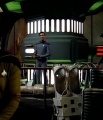
The warp core of a Constellation Class starship
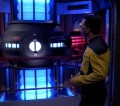
The warp core of a Galaxy Class starship

The enhanced warp core of a Nova Class starship

The warp core of an Intrepid Class starship

The warp core of a Sovereign Class starship

The warp core of the Delta Flyer II shuttle

The warp core of a D'deridex Class warbird
Matter-Antimatter Reaction Assembly [ edit ]
A matter/antimatter reaction assembly (often known simply as an M/ARA) is a type of energy reactor which is fueled by injectors of matter and antimatter into a central reaction element, creating large amounts of energy when those two materials mutually annihilate each other. Matter and antimatter is injected into the M/ARA in an intermix 1:1 ratio. (TNG: "Coming of Age") The dilithium crystal is used to moderate this reaction.
The dilithium articulation frame is housed inside the M/ARA, (TNG: "Skin of Evil") behind the dilithium chamber hatch. (TNG: "The Drumhead")
The prototype Jem'Hadar battleship had a fatal design flaw; the braces holding together the ship's M/ARA were vulnerable to a specific type of radiation. The crew of the USS Valiant believed they could use this flaw to their advantage when they were plotting the ship's destruction in 2374. (DS9: "Valiant")
Antimatter Injector [ edit ]
An antimatter injector is a device in antimatter containment which precisely compresses and streams antimatter into the form which enters the dilithium articulation frame in a starship's warp core. (ENT: "Acquisition")
During the 2150s, Andorian battle cruisers were fitted with antimatter injectors that used variable-compression nozzles. At the time, the Andorians considered the technology as "very sophisticated," and knowledge about them as "rather sensitive." During the Xindi mission, Trip Tucker received an antimatter injector from Shran, as a favor, because, according to Tucker, "one of those injectors would work wonders for our engines." (ENT: "Proving Ground")
In 2374, a lone member of Species 8472 gained access to Main Engineering on the USS Voyager through the antimatter injector port. It attacked the engineering crew, though it did not damage the ship. (VOY: "Prey")
In late 2375, when the USS Defiant was about to leave Deep Space 9 for the Chin'toka system, Colonel Kira Nerys opened the ship's antimatter injector ports. (DS9: "The Changing Face of Evil")
Dilithium Crystal Chamber [ edit ]
The dilithium crystal chamber is a component in a starship's warp core that contains the dilithium crystals. (TNG: "Galaxy's Child", "The Drumhead", "Cost of Living")
The dilithium crystal chamber for the USS Enterprise-D was designed at Outpost Seran T-1 on stardate 40052. (TNG: "Booby Trap")
Dilithium Chamber Hatch [ edit ]
The dilithium chamber hatch aboard Federation starships is a reinforced plate which fits over the exterior entrance to the matter-antimatter reaction assembly with the dilithium articulation frame immediately behind it.
In 2367, the dilithium chamber hatch aboard the USS Enterprise-D exploded; although sabotage was suspected, a subtle manufacturing flaw in the hatch (replaced at Earth Station McKinley earlier that year) was to blame. (TNG: "The Best of Both Worlds, Part II", "The Drumhead")
Dilithium Crystal [ edit ]
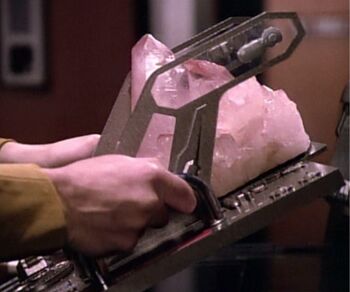
Dilithium, also known as radan is an element, a member of the hypersonic series, mostly occurring as crystalline mineral. It was used in the warp drive systems of many starships. Dilithium regulated the matter/antimatter reaction in a ship's warp core because of its ability to be rendered porous to light-element antimatter when exposed to high temperatures and pressures. It controls the amount of power generated in the reaction chamber, channeling the energy released by mutual annihilation into a stream of electro-plasma.
Dilithium could be found on only a few planets in the galaxy, and was therefore a rare and valuable substance. Notable sources of dilithium included Coridan and Elas in the Federation, as well as Rura Penthe in the Klingon Empire and Remus in the Romulan Star Empire. (TOS: "Journey to Babel", "Elaan of Troyius"; Star Trek VI: The Undiscovered Country; DS9: "One Little Ship"; Star Trek Nemesis) It could also be found on Troyius, where it was known as radan, and had a variety of different uses, including jewelry. (TOS: "Elaan of Troyius")
Under certain rare circumstances, dilithium deposits could form in such a way that the crystals grow into perfectly aligned lattices. If enough dilithium is present, it began to form "generator strata". A piezoelectric effect occurred when the crystals took the radiant heat of the planet and converted it into mechanical energy.
This mechanical energy could increase tectonic stresses in a planet's crust to the point where the planet literally tore itself apart. This phenomenon was responsible for the destruction of a number of planets in the Selcundi Drema sector.
One method of detecting the potential presence of dilithium deposits during a geological survey was by studying UV (ultraviolet light) absorption patterns. Certain characteristic patterns tended to indicate the presence of traker deposits, which were commonly formed along with the dilithium ore. An ico-spectrogram could then be run to confirm the ore's presence. (TNG: "Pen Pals")
After being sent back in time to 1947, Quark asked US General Rex Denning if dilithium was used as a currency. (DS9: "Little Green Men")
Constitution-class starships continued to use crystallized lithium until the mid-2260s, before switching to dilithium. Housed in a dilithium crystal converter assembly, the crystals were used as a power source as well as a regulator. Dependency on that power meant the starships risked losing the ability to maintain an orbit, let alone use of their warp drive, when a number of dilithium crystals were drained of their power or became fused in their assembly. In some circumstances, crystals could be re-amplified to provide continued service, rather than replaced. (TOS: "Mudd's Women", "The Alternative Factor", "Elaan of Troyius")
One of the reasons why dilithium was so valuable before the late 23rd century was because dilithium gradually decrystalizes during use, and there existed no practical means of inducing recrystallization. However, during a time travel mission to 1986, Spock and Scotty developed a method of recrystallizing dilithium through exposure to gamma radiation.
Decrystalizing dilithium resulted in certain byproducts, including illium-629 and, when used in warp cores, trilithium resin. (TNG: "Pen Pals", "Starship Mine")
By the 2360s, it was possible to recrystallize dilithium while it was still enclosed in the warp core's dilithium articulation frame using a theta-matrix compositor. (Star Trek IV: The Voyage Home; TNG: "Relics")
Dozaria was rich in dilithium, which attracted the Breen to the planet. In 2366, they forced the Ravinok to crash on the planet and put the survivors to work in the dilithium mine. (DS9: "Indiscretion")
In 2372, the USS Voyager discovered a new form of dilithium in the Delta Quadrant that remained stable at much higher reaction rates, allowing a vessel to travel more efficiently at much higher speeds. This dilithium was installed aboard the shuttlecraft Cochrane to test an experimental warp 10 flight. (VOY: "Threshold")
Dukat and Damar were able to trick Captain K'Temang into believing the Groumall was carrying refined dilithium crystals by modifying the Cardassian freighter's subspace transceiver array to emit a false dilithium signal. (DS9: "Return to Grace")
Odo and several members of the Cardassian Rebellion destroyed the Tevak shipyards by sabotaging the dilithium in its storage bunkers. (DS9: "Tacking Into the Wind")
Lyndsay Ballard said that dilithium extraction was always one of B'Elanna Torres' specialties. (VOY: "Ashes to Ashes") Torres helped Neelix prepare for a mining operation by giving him material to study on dilithium geophysics. (VOY: "Phage")
Dilithium Articulation Frame [ edit ]
The dilithium articulation frame holds the dilithium in alignment with the colliding matter/antimatter stream and is housed inside the matter-antimatter reaction assembly. The frame is housed behind the dilithium chamber hatch. (TNG: "The Drumhead")
Doctor Leah Brahms inspected the dilithium articulation frame of the USS Enterprise-D in 2367 and discovered that Geordi La Forge had modified the articulation frame. (TNG: "Galaxy's Child")
The frame suspends the dilithum in the reaction chamber using a field effect to keep the crystal faces in alignment with the matter/antimatter streams. The correct alignment of the crystal faces and planes maximizes the efficiency of the plasma conversion that takes place. By the 2360s, the theta-matrix compositor was integrated with the articulation frame, allowing recrystallization to take place in the warp core with the core online. (TNG: "Relics")
Matter Injector/Deuterium injector [ edit ]
The deuterium injector, or simply matter injector, is a component of starship's warp core, which precisely compresses and streams matter (deuterium) into the form which enters the dilithium articulation frame.
In 2372 in the mirror universe, Benjamin Sisko took the Defiant's deuterium injector offline and online again. It required the flow regulators to be shut off. (DS9: "Shattered Mirror")
The Red Squad cadets often had trouble with the USS Valiant's deuterium injector startup routine, as the system often experienced power spikes. When he came aboard, Nog suggested doing what Chief O'Brien had done on the USS Defiant, by recalibrating the lateral impulse control system. (DS9: "Valiant")
Theta-matrix Compositor [ edit ]
The theta-matrix compositor is a device aboard Federation starships in the 24th century, such as the Galaxy-class and the Intrepid-class. It is used to recrystalize dilithium crystals while still in the articulation frame of a warp core. (TNG: "Family", VOY: "Innocence")
- Engineering
Navigation menu
Personal tools.
- Not logged in
- Contributions
- View history
- Recent changes
- Random Image
- Random Article

Popular Wiki Pages
Retired or destroyed.
- USS Templar
- USS Paladin
- USS Rosenante
- USS Boudicca
- USS Cochrane
- USS Firebrande
- USS Dennison
- USS Champlain
- USS Mithrandir
- USS Mystique
- USS Starfire
- USS Spectre
STF History
- What links here
- Related changes
- Special pages
- Printable version
- Permanent link
- Page information
- Cite this page
- This page was last edited on 14 January 2012, at 09:44.
- Privacy policy
- About Star Trek : Freedom's Wiki
- Disclaimers
A warp core is a matter-antimatter reactor used to provide power for starships in Star Trek . Its primary purpose is to provide power for the warp drive , but "warp power" is also used to supply many other systems.
- 2.1 Incidents
- 4 References
Inside a warp core, matter and antimatter are allowed to contact and annihilate each other within a magnetic containment field. Dilithium crystals are used to control the reaction, and their orientation affects the efficiency of the reaction. [1] Energy from the reaction is collected in the form of plasma and piped around the ship through "plasma conduits" to power various systems, especially the warp drive .
Warp cores are prone to excess reactivity, making them incredibly dangerous to operate. When operating, a warp core typically contains enough antimatter to destroy its ship if the magnetic field isolating the fuel from the containment vessel should fail.
Warp core safety systems, especially aboard Galaxy -class starships , are prone to failure themselves. Systems designed to shut down the reactor in an emergency routinely fail, and the warp core ejection system -- a last-ditch option that launches the entire core into space -- has also repeatedly failed to operate when needed.
For example, see the destruction of the Enterprise in TNG "Cause and Effect". Note that both of the "failsafe" systems to prevent the destruction of the ship fail: both an emergency shutdown of the warp core and an emergency ejection of the warp core. Likewise, in Star Trek: Generations , neither the shutdown nor the ejection system works, and the crew is forced to evacuate the engineering section and separate it from the saucer before it explodes (even then, the blast damages the saucer and causes it to crash).
- Enterprise , NX-01; destroyed in alternate timeline by a deliberate core breach.
- Enterprise , NX-01 (Mirror Universe); destroyed in battle due to a jammed AM ejection system.
- USS Enterprise , NCC-1701-D; destroyed multiple times in various timelines, permanently destroyed by core breach in Star Trek: Generations . Several other near misses involving a runaway warp core also occurred.
- USS Enterprise , NCC-1701-E; this breach was remotely triggered after core ejection.
- USS Yamato ; destroyed by an AM containment failure (TNG "Contagion").
- Farrakk's starship; sabotaged.
- USS Orinoco ; sabotaged.
- Antimatter pod
- ↑ TNG "Booby Trap"
- ST Starship Propulsion
- ST Technology
Navigation menu

USS Enterprise (NCC-1701-D)
- View history
The USS Enterprise (NCC-1701-D) was a Federation Galaxy -class starship operated by Starfleet , and the fifth Federation vessel to bear the name . The Enterprise served from 2363 to 2371 as the Federation flagship , under the command of Captain Jean-Luc Picard . Following the ship's destruction at Veridian III , it was rebuilt as a museum ship , and was briefly brought back into service to counter a Borg threat in 2401 .
- 1.1 Construction and launch
- 1.2 Picard's eight-year mission
- 1.3 Destruction
- 1.4 Reconstruction
- 1.5 Emergency return to action
- 1.6 Final retirement
- 3 List of first contacts
- 4.1 Physical arrangement
- 4.2 Weaponry
- 4.3 Operations
- 4.4 Shipboard life
- 4.5 Ship's directory
- 5.1 Commanding officers
- 5.2 Command crew
- 6.1 Encounter with an energy vortex
- 6.2 Encounter with the Enterprise -C
- 6.3 Crusher's static warp bubble
- 6.4 Barash’s simulation – Captain Riker
- 6.5 Quantum fissure encounter
- 6.6 Anti-time eruption
- 6.7 Destruction at Veridian III
- 7.1 Appearances
- 7.2 Background information
- 7.3.1 Reference manuals
- 7.3.2 Games
- 7.3.3 Attractions
- 7.4 External links
Service history [ ]
Construction and launch [ ].
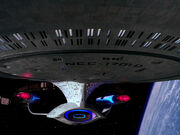
Enterprise at Earth Station McKinley
The Enterprise was built at Utopia Planitia Fleet Yards orbiting Mars in the Sol system . The construction was a massive undertaking, involving thousands of people across disciplines. ( TNG : " Booby Trap ", " Eye of the Beholder ") Construction was supervised by Commander Quinteros . ( TNG : " 11001001 ") Dr. Leah Brahms was responsible for much of the Enterprise 's warp propulsion system design. ( TNG : " Booby Trap ", " Galaxy's Child ") Some of the Enterprise 's components were derived from technology originally developed on the USS Pegasus . ( TNG : " The Pegasus ") In an alternate timeline , the Enterprise was the first Galaxy -class warship constructed. ( TNG : " Yesterday's Enterprise ")
One of the ship's nacelle tubes was the site of a multiple murder - suicide while it was still under construction at Utopia Planitia. A member of the construction team, Walter Pierce , became jealous of a former lover's new relationship. He killed the two officers, Marla Finn and William Hodges , then disposed of their bodies in the plasma stream . Pierce committed suicide in the same manner, leaving a telepathic imprint in a bulkhead that was not discovered until 2370 . ( TNG : " Eye of the Beholder ")
On stardate 40759.5, in the year 2363 , the Enterprise was launched from Mars. ( Enterprise -D dedication plaque, second version ) On stardate 41025.5, the Enterprise was commissioned. ( Enterprise -D dedication plaque, first version )
Final systems completion and shakedown was conducted at Earth Station McKinley . Captain Jean-Luc Picard took command of the ship on stardate 41148 at the order of Rear Admiral Norah Satie . ( TNG : " All Good Things... ")
Picard's eight-year mission [ ]
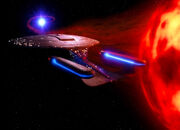
In orbit of a red giant star
The Enterprise -D made first official contact with a number of species ( see below ).
While fleeing from the entity known as Q ; the Enterprise conducted the first high-warp (warp 9.6) saucer separation . ( TNG : " Encounter at Farpoint ") The Traveler used the energy of his thoughts to move the Enterprise to a galaxy known as M-33 at a speed greater than warp 10 . A subsequent use of the warp drive by the Traveler propelled the Enterprise to the end of the universe at a speed that, according to the ship's instruments, never exceeded warp 1.5. ( TNG : " Where No One Has Gone Before ")
The Enterprise received a computer refit in 2364 . ( TNG : " Datalore ")
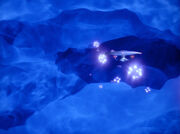
Arriving at the end of the universe
Later in 2364, the Enterprise was hijacked from Starbase 74 by the Bynars . They intended to use the ship to repair the damaged computer on their homeworld . The Enterprise was returned to Captain Picard's control following the incident, and the Bynars freely accepted the consequences of their actions. ( TNG : " 11001001 ")
During its first encounter with the Borg , Sections 27, 28, and 29 on Decks 4, 5, and 6 were removed for analysis by the Borg. Eighteen people were killed. ( TNG : " Q Who ")
In 2366 , the Enterprise had traveled about ten thousand light years . ( TNG : " Booby Trap ")
During the Borg incursion of 2366 and 2367 , the Enterprise suffered heavy damage. Deck 36, including main engineering, was decompressed after a cutting beam damaged the engineering hull , killing at least eleven, and possibly eight more. ( TNG : " The Best of Both Worlds ")

Undergoing repairs at Earth
The main deflector dish was transformed into a last-ditch energy weapon, which failed due to the assimilated knowledge of Captain Picard. In the attempt, the deflector and warp core were overloaded, while several decks were flooded with radiation .
Later, the saucer module sustained damage to its impulse drive and Decks 23 through 25 were sliced open by the enemy during the final battle over Earth . ( TNG : " The Best of Both Worlds, Part II ") The extent of the damage required a full refit at Earth Station McKinley, which lasted five to six weeks. ( TNG : " Family ")
During that refit, the starship received a phaser upgrade as well as full damage repair and a new dilithium chamber hatch . The hatch malfunctioned later that year, causing extensive damage to the warp core. Although Romulan sabotage was initially suspected, it was later learned that undetected flaws in the hatch were responsible. ( TNG : " The Drumhead ")
The Enterprise was the command ship in Captain Picard's ad hoc armada which blockaded Romulan assistance to the House of Duras during the Klingon Civil War . It coordinated a tachyon detection grid which was used to detect cloaked Romulan ships from crossing the border. ( TNG : " Redemption II ")
The ship struck a quantum filament in early 2368 , causing a loss of all power aboard ship and severe damage to most systems. Antimatter containment was nearly compromised; fortunately, repairs were made before the ship was destroyed. ( TNG : " Disaster ")
Also in 2368, the Enterprise was trapped in a temporal causality loop near the Typhon Expanse . Each cycle ended in a catastrophic collision with the USS Bozeman , destroying both ships. Feelings of déjà vu allowed the Enterprise crew to gather clues which allowed them to send a message into the next loop and avoid the collision. The ship spent a total of 17.4 days repeating the same interval of time. ( TNG : " Cause And Effect ")
On a mission to Ligos VII , the Enterprise was attacked by two Klingon Bird-of-Prey starships under the command of the Ferengi DaiMon Lurin . The surprise attack allowed Lurin and his men to successfully hijack the Enterprise. Forcing its crew to transport to the surface of Ligos VII for slave labor , Lurin had planned to sell the Enterprise to the Romulans, however, his plans were thwarted by a group of crewmembers who had temporarily been transformed into children due to a transporter malfunction. ( TNG : " Rascals ")
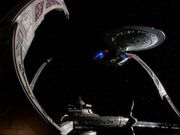
The Enterprise at Deep Space 9
The Enterprise was one of the first Starfleet vessels to dock at the newly-commissioned Deep Space 9 , where it offloaded most of the station's Starfleet contingent, and its first complement of Danube -class runabouts . The Enterprise departed the station and heading to the Lapolis system . ( DS9 : " Emissary ") Several weeks later, the Enterprise returned to Deep Space 9 to help repair the Bajoran aqueduct systems that had been damaged during the Cardassian Occupation of Bajor . ( TNG : " Birthright, Part I ", " Birthright, Part II ")
The Enterprise underwent its first baryon sweep at the Remmler Array in 2369 . A stronger field was needed due to the Enterprise 's heavy use of warp drive. During the sweep, a mercenary group nearly stole dangerous trilithium resin from the warp core, but was thwarted by the Enterprise senior staff . ( TNG : " Starship Mine ")
One of the most important discoveries in the history of the Federation was made aboard the Enterprise -D. Its crew pieced together Dr. Galen 's final research to decipher a message from the ancient humanoids , the first humanoid species in the Milky Way Galaxy . ( TNG : " The Chase ")
Late in 2369 , the Enterprise was damaged while rescuing the crew of a Romulan warbird , whose artificial quantum singularity warp core had been colonized by lifeforms which mistook it for a genuine quantum singularity, causing severe disruptions in space - time .
The Enterprise was destroyed due to feedback from a power transfer beam , which was killing the lifeforms' young. Fortunately, four Enterprise crewmembers were returning to the ship at the time and were able to avert the Enterprise 's destruction and save the Romulan crew. ( TNG : " Timescape ")
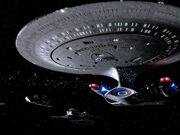
The Enterprise at Qualor II
A new warp core was tested aboard the Enterprise in early 2370 . The core was installed at Starbase 84 ; several points of the power transfer conduits were replaced as well.
The core and the conduits had been manufactured on Thanatos VII using interphase technology, attracting interphasic organisms which attached themselves to the crew and began to digest their cellular structures . An interphasic pulse was successful in destroying the creatures. ( TNG : " Phantasms ")
Also during 2370, Commander La Forge engaged in a friendly contest with Donald Kaplan , chief engineer of the USS Intrepid . They competed to have the best power conversion rates in the fleet, with the Enterprise frequently beating out the Intrepid . ( TNG : " Force of Nature ")
The Enterprise became one of the few Federation ships to use a cloaking device in 2370, and perhaps the first to successfully use a phasing cloak . It had been retrieved from the wreckage of the USS Pegasus and was installed aboard the Enterprise to allow it to pass through an asteroid after a Romulan vessel sealed the ship inside. ( TNG : " The Pegasus ")
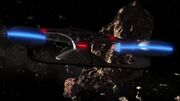
Investigating the asteroid field in 2370
While investigating a rogue comet in 2370, the Enterprise stumbled upon an archive of the lost D'Arsay civilization. The archive trapped the ship and used matter and DNA aboard to create artifacts from the D'Arsay culture. The Enterprise was later returned to normal. ( TNG : " Masks ")
Lieutenant Worf supervised an upgrade of the Enterprise 's weapons systems in late 2370. The tests were interrupted after the ship was ravaged by Barclay's Protomorphosis Syndrome . ( TNG : " Genesis ")
At some unspecified point in 2370, the Enterprise -D docked at Deep Space 9, where some of the crew went on shore leave , and Lieutenant Jadzia Dax staked Commander Riker three strips of gold-pressed latinum when Riker's winning-streak ran dry at Quark's . Riker would later contact Quark and trade his unclaimed winnings for information on the Duras sisters. ( TNG : " Firstborn "; DS9 : " Defiant ")
The Enterprise temporarily became sentient in 2370 when an emergent lifeform used the ship's systems to reproduce. ( TNG : " Emergence ")
When Miles O'Brien , one of the ship's former transporter chiefs , was captured by the Cardassians in late 2370, the Enterprise along with Prokofiev , and Valdemar were sent to patrol the Demilitarized Zone as a warning to the Cardassian government . ( DS9 : " Tribunal ")
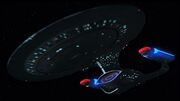
The Enterprise in 2371
In early 2371 , the Enterprise received a number of refits to its internal spaces. Color and lighting schemes were slightly altered, and the bridge inherited a number of new consoles on the port and starboard sides. There were now four science stations , three along the starboard wall and one at the starboard side of the aft stations. Mission Ops was now the second station, followed by environmental control . Two engineering stations rounded out the aft area, while three communications stations were present along the port wall.

The Enterprise -D arrives at Amargosa
In addition, the main floor (where the captain's, executive officer's, and guest's chairs were) was slightly raised, and a chair was placed at the tactical station for the chief of security to sit while manning that console.
Later that year, the Enterprise picked up a distress call from the observatory in the Amargosa system . An away team led by Commander Riker found that the station had been attacked by Romulans, they also found an injured Doctor Tolian Soran buried among the wreckage. After analyzing the Romulan tricorder , they discovered the Romulans were looking for trilithium . Back on the station, Data and La Forge discovered a secret lab filled with solar probes when they are attacked by Soran. Soran then launched a solar probe that destroyed the Amargosa star, producing a level-12 shock wave , after rescuing Data, the Enterprise left the system as the observatory was destroyed.

The Enterprise in orbit of Veridian III
After talking with Guinan about Soran and the Nexus , Picard met with Data in Stellar cartography , where they discovered that Soran was altering the course of the energy ribbon. Picard determined Soran was heading for the Veridian system and ordered Worf to set course at maximum warp. The Enterprise arrived at Veridian III and intercepted a renegade Klingon Bird-of-Prey commanded by the Duras sisters. The Klingons agreed to a "prisoner exchange" for La Forge, taking Picard in his place and allowing him to beam to Soran's location somewhere on the planet's surface. ( Star Trek Generations )
Destruction [ ]
However, an subsequent engagement with the Bird-of-Prey resulted in extensive damage to the Enterprise . The ship's magnetic interlocks were ruptured, and before efforts could be made to repair them, a coolant leak began, leading to an unavoidable warp core breach .

The Enterprise 's stardrive section is destroyed
Faced with this scenario, Commander Riker ordered the evacuation of the crew from the secondary hull to the saucer section . Once the evacuation had been completed, the saucer could separate and get to a safe distance before the stardrive section was destroyed by the core breach. La Forge and Dr. Crusher oversaw the evacuations of their respective departments and completed it with a minute to spare. The saucer's impulse engines were engaged as soon as it cleared the secondary hull, but the saucer was unable to get to a safe distance before the core breached. The explosion produced a ion shock wave that disabled the entire saucer section and propelled it into a degrading orbit of Veridian III, forcing the saucer section into the planet's atmosphere .

The saucer section of the Enterprise grinds to a halt on Veridian III
With the saucer hurtling towards the surface of the planet, Data managed to reroute the auxiliary systems to the lateral thrusters and thereby restore thruster control to level out their descent. Moments later, the saucer crash-landed into a jungle on the planet's surface, flattening many trees as it came to rest. Owing to the relatively safe landing, casualties on the Enterprise were minimal. Unfortunately, the severe damage sustained by the primary hull in the battle and subsequent crash landing apparently rendered the ship unsalvageable. The ship's crew was rescued by three Starfleet vessels, including the Nebula -class USS Farragut , an Oberth -class ship , and a Miranda -class ship . ( Star Trek Generations )
Reconstruction [ ]
Due to Prime Directive concerns, the crashed saucer section was recovered and transported to the Fleet Museum . Upon taking stewardship of the Museum, Commodore Geordi La Forge spent twenty years restoring the ship to its original condition in Hangar Bay 12, forgoing her last refits from 2371, and using parts from the USS Syracuse to rebuild the secondary hull . He also repaired the extensive damage to the saucer section from the crash, with only cosmetic damage to the outer hull remaining. By Frontier Day in 2401 , the Enterprise -D was an operational starship once again, aside from some lingering issues that La Forge had yet to address. ( PIC : " The Star Gazer " commemorative plaque ; PIC : " Võx ")

Emergency return to action [ ]
In 2401 , when Picard came to the Fleet Museum in search of Geordi La Forge 's help with rescuing an away team from Daystrom Station , La Forge's daughter Alandra discreetly suggested using the Enterprise for the mission, but he instantly shot the idea down. Instead, Picard's son Jack Crusher and La Forge's other daughter Sidney stole the cloaking device from the HMS Bounty . ( PIC : " The Bounty ")

The crew standing on the restored bridge of the Enterprise -D

The Enterprise -D returns to service
On Frontier Day , La Forge revealed the Enterprise to the rest of its old command crew when they needed a ship not linked to the Starfleet mainframe , which had been used by the Borg to take over the Federation fleet. The ship was functional, barring some lingering issues. With the ship's computer identifying him as Captain Picard due to the long-outdated crew manifest , Picard jokingly accepted a field demotion to command the Enterprise again. ( PIC : " Võx ")
Picking up a distress call from President Anton Chekov , it was quickly determined that the Enterprise was the only help that was coming for Earth. Deducing that the Borg had to be close, the Enterprise located a Borg cube hiding in Jupiter 's Great Red Spot broadcasting the Borg Collective 's command signal - Jack Crusher. Data quickly determined the cube to only be 36% operational as most of its resources were being used to broadcast the signal. After detecting the Enterprise , the cube lowered its shields and redirected its weapons in an invitation. Deducing that there was a beacon transmitting the signal across the solar system, Picard, Riker and Worf beamed aboard to find Jack and the coordinates for the beacon so that the Enterprise could target it while La Forge, Doctor Crusher, Counselor Troi and Data remained on the ship to help guide them.
As Riker and Worf located the beacon, the cube opened fire on the Enterprise , but Crusher, displaying the accumulated skill of the past twenty years, was able to manually target the ship's weapons to take out the cube's defensive turrets. The information recovered by the away team revealed the beacon to be at the very heart of the cube, a location statistically impossible for even the best computer or pilot to reach.

The USS Enterprise -D escaping Jupiter with Jack Crusher following the destruction of the Borg Collective and the Borg Queen.
However, at Data's insistence, La Forge allowed him to fly the Enterprise through the cube's superstructure, with Crusher firing at any targets of opportunity that emerged along the ship's flight path. The ship eventually reached the beacon, which was discovered to be interfaced into the very substructure of the ship; its destruction would trigger a cataclysmic chain reaction that would destroy the Borg cube, and everyone on it.

The USS Enterprise -D and the USS Titan -A returning to Earth following their victory over the Borg.
The Enterprise hit the beacon with multiple phaser blasts and photon torpedos , destroying it and causing the cube to be consumed by a series of explosions. After Troi telepathically sensed her husband's farewell, she was able to fly the Enterprise over the away team's position and beam them out just in time. The Borg cube was destroyed, ending the Borg threat forever and breaking the Borg's control over Starfleet. As everyone celebrated, Picard welcomed his son to the Enterprise . ( PIC : " The Last Generation ")
Final retirement [ ]

The USS Enterprise -D was officially restored and took her place in the Fleet Museum.
After the battle at Jupiter, the Enterprise was returned to the Fleet Museum and her restoration continued (along with repairs). By 2402 the work was completed and she was put on display in a place of honor between the USS Enterprise -A and the USS Stargazer . Picard, La Forge and Riker reminisced on her bridge about the old ship, the number of times that she had managed to save the world and how it was difficult to imagine what they might've been without her. La Forge ordered the computer to initiate the shutdown procedure and promised to take good care of the Enterprise as "after all, she's always taken good care of us."
Soon afterwards, the USS Titan -A was rechristened the USS Enterprise -G in honor of the Enterprise -D and the heroic actions of her command crew. ( PIC : " The Last Generation ")
Commander Riker was upset over the loss of the Enterprise . Having hoped he would one day command the ship, he was disappointed that he never got that opportunity. However, Picard expressed doubt that the Enterprise -D would be the last vessel to carry the name. ( Star Trek Generations )
The Enterprise was so dear to Worf that, shortly after being reassigned to Deep Space 9 in 2372 , he briefly considered resigning from Starfleet . Station commander Captain Benjamin Sisko expressed regret on the loss of the Enterprise and offered his condolences over the destruction of the ship to Worf, saying the Enterprise "was a good ship." ( DS9 : " The Way of the Warrior ")

Picard dreams of the Enterprise -D in flight
Captain Picard's belief that the Enterprise -D would not be the final ship to bear the name was borne out with the christening of the Sovereign -class USS Enterprise -E in 2372. In that instance, the legacy of the Enterprise continued with Picard reprising his role as CO and selecting most of the former crew from the Enterprise -D, with the notable exception of Worf due to his recent assignment to DS9.
A gold model of the Enterprise -D was kept in a display case in the observation lounge of the Enterprise -E. Picard later destroyed it with a phaser rife in the fit of rage while discussing the Borg assimilation of the Enterprise -E with Lily Sloane . It was the image of the broken Enterprise -D model that helped convince Picard to set the auto-destruct sequence and abandon ship rather than be destroyed by his need for revenge against the Borg. ( Star Trek: First Contact )
Following a mission on Karzill IV in 2381 , Riker commented to Lieutenant Brad Boimler on how much he missed the exploration and scientific exploits of the Enterprise -D compared to the "non-stop fighting" he experienced as captain of the USS Titan . He advised Boimler to enjoy his reassignment to the USS Cerritos similarly to his time on the Enterprise. ( LD : , " Kayshon, His Eyes Open ")
The Enterprise -D served as the setting for a late-24th century version of the Kobayashi Maru scenario among the USS Protostar 's training programs. In 2383 , Dal R'El attempted the scenario numerous times before learning its lesson. ( PRO : " Kobayashi ")
In 2383 , Hologram Janeway showed the young crew of the USS Protostar an image of the Enterprise -D while explaining the history of the Federation and Starfleet to them. ( PRO : " Starstruck ")

Picard's dream of the Enterprise -D
In 2399 , Picard, sleeping at Château Picard in France , had a dream that he was in Ten Forward with Data on the Enterprise -D, playing a game of Poker . Nearing the end of the game, he stalled Data as best he could because he did not want the game to be over. They were seated at a table directly next to a window , which allowed Picard to notice Mars outside. He didn't realize that the Enterprise was on course for Mars, so this surprised him. He then watched as the entire planet exploded , engulfing the Enterprise as well, causing Picard to awaken from his dream. ( PIC : " Remembrance ")
Later that same year, a hologram of the Enterprise was displayed in the atrium of the CNC's office at Starfleet Headquarters . ( PIC : " Maps and Legends ")
By 2401 , the Enterprise -D was depicted on a commemorative plaque alongside other historic ships at Starfleet Academy . ( PIC : " The Star Gazer ")
Later that year, in preparation for Frontier Day , Guinan began selling models of the various starship Enterprise s, including the Enterprise -D at 10 Forward Avenue . However, much to Riker's chagrin, the Enterprise -D models proved to be unpopular, being seen as "the fat one". ( PIC : " The Next Generation ")
List of first contacts [ ]
In most cases, the date indicated is the first time open communication was initiated with at least one member of the species. Otherwise, it is the first known contact with the species.
- The Aldeans ( TNG : " When The Bough Breaks ")
- Armus ( TNG : " Skin Of Evil ")
- The Beta Renner cloud ( TNG : " Lonely Among Us ")
- The Crystalline Entity ( TNG : " Datalore ", " Silicon Avatar ")
- The Edo ( TNG : " Justice ")
- The Farpoint Station entities ( TNG : " Encounter at Farpoint ")
- The Ferengi ( TNG : " The Last Outpost ")
- Microbrain ( TNG : " Home Soil ")
- The parasitic beings ( TNG : " Conspiracy ")
- The Q Continuum ( TNG : " Encounter at Farpoint ")
- The Borg ( TNG : " Q Who ")
- Nagilum ( TNG : " Where Silence Has Lease ")
- Ian Andrew Troi, Jr. ( TNG : " The Child ")
- The nanite civilization ( TNG : " Evolution ")
- The Douwd ( TNG : " The Survivors ")
- The Mintakans ( TNG : " Who Watches The Watchers ")
- Gomtuu ( TNG : " Tin Man ")
- Koinonian energy being ( TNG : " The Bonding ")
- The Zalkonians ( TNG : " Transfigurations ")
- The Cytherians ( TNG : " The Nth Degree ")
- The Malcorians ( TNG : " First Contact ")
- The Enterprise -D also encountered the Paxans in 2367, but all recollection of that encounter was erased from the memories of the entire crew except for Data as well as from the ship's logs. ( TNG : " Clues ")
- First successful establishment of two-way communication. Actual first contact had occurred at least one century earlier.
- FGC 47 lifeforms ( TNG : " Imaginary Friend ")
- Criminals from Ux-Mal composed of anionic energy ( TNG : " Power Play ")
- The exocomps ( TNG : " The Quality of Life ")
- The quantum singularity lifeforms ( TNG : " Timescape ")
- The Solanogen-based lifeforms ( TNG : " Schisms ")
- The Boraalans ( TNG : " Homeward ")
- Emergent lifeform ( TNG : " Emergence ")
Technical data [ ]
Physical arrangement [ ].
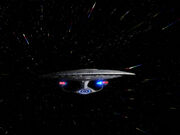
The Enterprise -D at warp
With a total of 42 decks, the USS Enterprise -D was twice the length and had eight times the interior space of the Constitution -class ships of over a century earlier ( TNG : " Yesterday's Enterprise ") it carried a combined crew and passenger load of 1,014. ( TNG : " Remember Me ", " Rascals ", " Genesis ")
The bridge , captain's ready room , and conference lounge were on Deck 1, and were protected by redundant safety interlocks to prevent environmental systems failure. ( TNG : " Brothers ")
The main shuttlebay was on Deck 4, supported by several cargo bays on Deck 4 and Deck 18. ( TNG : " Power Play ", " Schisms ") Two additional shuttlebays were found on Deck 13. ( TNG : " The Next Phase ")
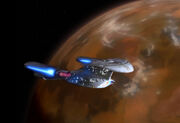
The secondary hull or stardrive section following a saucer separation
Deck 8 of the ship was an unfinished multipurpose deck. Additional workspaces were set there when needed. ( TNG : " Liaisons ") It also contained the officers' quarters, some guest quarters, and the battle bridge . ( TNG : " The Best of Both Worlds ", " Reunion ")
Deck 12 contained sickbay and the gymnasium , ( TNG : " Remember Me ", " The Icarus Factor ") while main engineering was located on Deck 36. ( TNG : " The Hunted ", " The Game ") Engineering took up twelve decks of the secondary hull , with the antimatter storage pods housed on Deck 42. ( TNG : " Liaisons ") There was a science section on deck 15. ( TNG : " In Theory ")
The primary docking ports were located on either side of the torpedo launcher on Deck 25; ( TNG : " 11001001 ") the nacelle control room was also on that deck. ( TNG : " Eye of the Beholder ") According to Lieutenant Commander Nella Daren , the most acoustically perfect spot on the ship was the fourth intersect of Jefferies tube 25. The intersection formed a resonance chamber for the sound compression waves. ( TNG : " Lessons ")
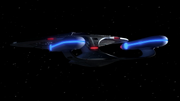
The ventral aft section

The aft section
The Enterprise had a maximum sustainable speed of warp 9.6 for twelve hours . ( TNG : " Encounter at Farpoint ")
The warp core could generate a tremendous amount of energy at once if needed; the only device on the ship capable of channeling such energy all at once, at controlled frequencies, was the main deflector dish. ( TNG : " The Best of Both Worlds ") There were some four thousand power systems in all on board the ship. It also had twenty transporter rooms, with at least one on deck 6. ( TNG : " 11001001 ", " Hollow Pursuits ", " Ménage à Troi ")
Weaponry [ ]
The armaments of the Enterprise -D included twelve phaser arrays , two torpedo launchers , a supply of 250 photon torpedoes , and hundreds of antimatter mines . The ship was protected by a high-capacity shield grid that could operate on multiple frequencies. When the ship was destroyed in 2371, the shield frequency was at 257.4 MHz. ( TNG : " Half a Life ", " Conundrum ", " Chain Of Command, Part II "; Star Trek Generations )
While on the rebuilt Enterprise in 2401, then-Captain Worf noted how he preferred the weaponry aboard its successor ship. ( PIC : " Võx ")
Operations [ ]
The bulk of the people on board the Enterprise could be evacuated within four minutes. This was executed at Starbase 74 during 2364 . ( TNG : " 11001001 ")
During emergency situations, certain large but protected areas of the ship were designated emergency shelters , including Ten Forward . Collectively, they could hold all the ship's crew and were designed so that the crew could reach one of the areas quickly. In 2367, while caught in a Tyken's Rift , the crew were ordered to these areas in order to get extra power from life support in non-shelter areas. ( TNG : " Night Terrors ")
Shipboard life [ ]
In 2367, an average day aboard ship recorded by Lieutenant Commander Data included four birthdays, two personnel transfers, two chess tournaments, a secondary school play, four promotions, and at least one birth. ( TNG : " Data's Day ")
The Enterprise normally ran on three duty shifts . ( TNG : " Lower Decks ") Increasing to four duty shifts caused many personnel scheduling problems, as observed when Captain Jellico ordered a change during his tenure in 2369 . ( TNG : " Chain Of Command, Part I ")
Crewmembers of ensign rank were required to share crew quarters but were allowed their own quarters upon promotion to lieutenant junior grade . ( TNG : " Lower Decks ") Families often shared quarters. ( TNG : " Lonely Among Us ", " When The Bough Breaks ", " Imaginary Friend ", " A Fistful of Datas ", " Journey's End ")
The Enterprise had five day care centers and at least seven classrooms . ( LD : " Kayshon, His Eyes Open ", TNG : " Rascals ")
Ten Forward , located at the extreme forward of Deck 10 in the saucer section, was the center of the ship's social activity; nearly everyone on board passed through the lounge at one time or another. ( TNG : " The Child ", " The Offspring ") Holodecks located on Deck 10 and Deck 12 also provided entertainment for the crew. ( TNG : " The Big Goodbye ", " Homeward ")
Ship's directory [ ]
- Room 2713: Lieutenant Worf 's quarters, 2370 ( TNG : " Parallels ")
- Room 3653: Lieutenant Commander Data 's quarters , 2370 ( TNG : " Masks ")
- Section 19, Room 1947: Lieutenant Edward Hagler 's quarters ( TNG : " Schisms ")
- Section 25 Baker, Room: Lieutenant Worf's quarters, 2369 ( TNG : " Rightful Heir ")
- Room 0910: Commander Deanna Troi 's quarters, 2368 - 2370 ( TNG : " Violations ", " Genesis ")
- Room 0912: Commander William T. Riker 's quarters ( TNG : " The Best of Both Worlds ", " Chain Of Command, Part II ")
- Room 2133: Commander Beverly Crusher 's quarters, 2370 ( TNG : " Sub Rosa ")
- Room 3402: Counselor Deanna Troi's office ( TNG : " The Price ")
- Section 4, Room 4711: Lieutenant Ro Laren 's quarters, 2370 ( TNG : " Preemptive Strike ")
- Marla Aster and Jeremy Aster 's quarters, 2366 ( TNG : " The Bonding ")
- Room 0910: Counselor Deanna Troi's quarters, 2366 ( TNG : " The Price ")
- Room 0929: Ensign Maddy Calloway 's quarters ( TNG : " Eye of the Beholder ")
- Room 3601: Captain Jean-Luc Picard 's quarters ( TNG : " Allegiance ")
- Section 28: Commander Beverly Crusher's quarters, 2368 ( TNG : " Cause And Effect ")
As of 2366, some thirteen species were represented among the 1,014 members of the ship's complement , at that time including Betazoid , Klingon, El-Aurian , Vulcan , and Human . ( TNG : " Remember Me ", " Reunion ") Over the course of its mission, crew species included Bolian , Benzite , Bajoran , Napean , and an android . When Lal was considering an Andorian form, Troi told her that she would be alone, meaning there were no Andorians or at least no Andorian females on the ship then. ( TNG : " The Offspring ") As of 2369, there were seventeen crew members from non-Federation worlds. ( TNG : " The Chase ") The ship also carried dolphins . ( TNG : " The Perfect Mate ")
Beverly Crusher said there were supposed to be at least four people on duty in sickbay at all times. ( TNG : " Remember Me ")
Although Starfleet crewmembers staffed the vital positions on board the Enterprise , civilian crewmembers were allowed to hold important jobs in the ship's science and medical departments, as well as support areas like Ten Forward and the ship's school or the arboretum. ( TNG : " Night Terrors ", " Hero Worship ", " Ethics ") The Enterprise included children among the civilians on board, a concept which was not initially embraced by Captain Picard. ( TNG : " Encounter at Farpoint ", " The Bonding ")
Crew evaluations were conducted every three months, and were usually supervised by Executive Officer William Riker and Counselor Deanna Troi. ( TNG : " Man Of The People ", " Lower Decks ", " Eye of the Beholder ")
Commanding officers [ ]
Although Captain Jean-Luc Picard commanded the Enterprise for most of the starship's life, his first officer , William Riker, was field promoted to captain in 2367 following Picard's capture by the Borg and assimilation as Locutus . ( TNG : " The Best of Both Worlds, Part II ") In early 2369, the Enterprise was briefly commanded by Captain Edward Jellico, as Captain Picard was assigned to a covert mission on the Cardassian planet of Celtris III . ( TNG : " Chain Of Command, Part I ", " Chain Of Command, Part II ")
Command crew [ ]
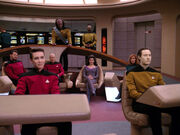
The Enterprise -D under Captain Jean-Luc Picard
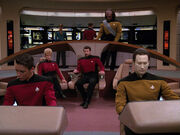
The Enterprise -D under the command of Captain William T. Riker in 2367
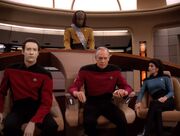
The Enterprise -D under the command of Captain Edward Jellico in 2369

The Enterprise -D under the command of Admiral Jean-Luc Picard in 2401
- Jean-Luc Picard ( 2363 – 2371 , 2401 )
- William T. Riker ( 2367 )
- Edward Jellico ( 2369 )
- Beverly Crusher (2370, temporary)
- Geordi La Forge (2401, temporary)
- William T. Riker (2364–2371)
- Kurn ( 2366 ) (temporary)
- Elizabeth Shelby (2367)
- Data (2369) (temporary)
- Data (2364–2371)
- Daystrom Android M-5-10 (2401)
- MacDougal (2364)
- Argyle (2364)
- Logan (2364)
- Leland T. Lynch (2364)
- Geordi La Forge ( 2365 –2371, 2401)
- Natasha Yar (2364)
- Worf (2364 – 2371)
- Worf (2364 – 2371, 2401)
- Burke (2365)
- Taitt ( 2370 )
- Beverly Crusher (2401)
- Beverly Crusher (2364, 2366)
- Katherine Pulaski (2365)
- Deanna Troi (2364–2371)
- Geordi La Forge (2364)
- Worf (2364)
- Miles O'Brien (2364)
- Wesley Crusher (2364–2367)
- Ro Laren ( 2368 –2369, 2370)
- Graham (2367)
- Sariel Rager (2367–2369)
- Gates (2368–2370)
- McKnight (2367–2369)
- Sam Lavelle (2370)
- Deanna Troi (2371, 2401) (temporary)
- Swenson (2364)
- Taitt (2370)
- Miles O'Brien (2365–2369)
- Maggie Hubbell (2367–2369)
Alternate Enterprise s [ ]
Numerous alternate timeline and illusory versions of the Enterprise have been encountered.
Encounter with an energy vortex [ ]
One alternate version of the Enterprise was observed in 2365 . A ship from several hours in the future was destroyed following an encounter with an energy vortex , which was later determined to be a sentient presence. There was a single survivor, Captain Picard, who was thrown back in time and picked up by the Enterprise . The "present" Picard was able to determine that the Enterprise needed to fly through the anomaly rather than attempt to escape it via the entrance, and the timeline was averted. ( TNG : " Time Squared ")
Encounter with the Enterprise -C [ ]
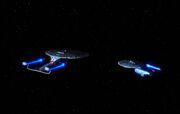
Two Enterprise s meet
In another alternate timeline, following the disappearance of the USS Enterprise -C , and the destruction of the Klingon outpost at Narendra III , relations between the Federation and the Klingon Empire deteriorated into war .
The Enterprise -D in this alternate timeline was the first of the Galaxy -class warships constructed by the Federation, capable of carrying over 6,000 troops. The vessel was entirely militarized, with no civilians or counselor . The bridge contained multiple redundant consoles, computer panels along the side walls, and a single command chair for the captain. The observation lounge was a war room instead, with the table at waist height so that the crew stood. Replicators throughout the ship were restricted to minimal power, lighting was generally darker, and all available power was routed to the defensive systems. In addition to crew performing their normal duties, there were additional security officers standing at attention at all times.
In 2366, on combat date 43625.2, the Enterprise -D investigated a radiation anomaly near Starbase 105 , where it encountered the Enterprise -C, transported through time by an anomaly called a temporal rift . As the Enterprise -D assisted in repairs, it was made clear that the Enterprise -C had to return through the rift, in order to prevent the chain of events that would lead to war. Enterprise -D's El-Aurian bartender Guinan was aware of the change to the timeline, and convinced Captain Picard to send the Enterprise -C back through the rift.
As three Klingon K'vort -class battle cruisers attacked, the Enterprise -D laid down cover fire in order for the Enterprise -C to return through the rift. Heavy casualties were suffered, and the vessel was on the verge of a warp core breach when the timeline was restored. However, the Enterprise -C crew retained memories of their encounter, and one Enterprise -D crewmember, Tasha Yar , went back in time with the Enterprise -C. ( TNG : " Yesterday's Enterprise ", " Redemption II ")
Crusher's static warp bubble [ ]
In 2367, the thoughts of Dr. Beverly Crusher after she was trapped in a warp bubble created a completely separate universe, in which people and objects began disappearing. At various points, the crew of the Enterprise was reduced to a normal operating contingent of about three hundred, then one hundred, then simply two. All crew eventually disappeared, as the bubble began to collapse and the universe destroyed. This Enterprise was gradually erased from existence as the bubble collapsed. ( TNG : " Remember Me ")
Barash’s simulation – Captain Riker [ ]
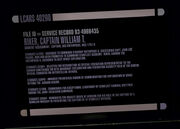
USS Enterprise in Riker's service record
In 2367, while exploring a cavern on Alpha Onias III , Commander William Riker was rendered unconscious by gases . While unconscious, neural scanners scanned Commander Riker's brain . The scanners used elements of Riker's reality and constructed a simulation with those elements interspersed throughout so that it felt real to him. What Riker wanted, the scanners made possible.
In the first simulation, set in 2383 , Riker was the captain of the Enterprise and was in the final stages of securing a peace treaty with the Romulans.
In 2374 , on stardate 51253, after serving for many years as the captain of the USS Titan , Riker succeeded Picard as the captain of the Enterprise . The ship's first assignment under his command was a deep space exploration mission. Under his command, the ship surveyed the space beyond the Sargon Region , was a participant in the joint Excalbian Campaign , and captured a Romulan warship. These events were mentioned in his service record that was on display in his quarters on the Enterprise -D.
A few years before 2383, a Romulan battle cruiser had drifted into Federation space. The ship's warp coils had collapsed and life support was failing. The Enterprise rescued the crew. Riker was the key spokesman in securing an alliance with the Romulans, who were impressed with his efforts at saving one of their ships. In the sixteen years between 2367 and 2383, the Enterprise saved all the colonists in the Fornax Disaster .
Riker was a widower with a son, Jean-Luc . His wife had been the ship's counselor after Troi had accepted a position at Starfleet Command. His wife died in 2381 in a shuttlecraft accident.
In 2383, Data served as the first officer while La Forge was using cloned eye implants instead of his VISOR . There were Klingons and Ferengi serving aboard the Enterprise . The interior of the ship was also slightly altered and the bridge had several more science stations. The Enterprise had been assigned an escort mission for the Romulan ambassador Tomalak , whereupon he would be delivered to the final session for a peace treaty between the Federation and the Romulans. At this session, Riker would be a signatory to the treaty.
However, a number of flaws convinced Riker that what he was experiencing was a charade and he challenged the program. This resulted in a new simulation where Riker was a prisoner of the Romulans. ( TNG : " Future Imperfect " okudagram )
Quantum fissure encounter [ ]
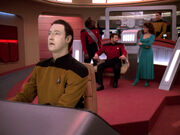
The bridge of an alternate Enterprise -D
Several thousand Enterprise s from many different quantum realities were encountered – later spilling into a single universe – in early 2370 , as a result of Lieutenant Worf's encounter with a quantum fissure .
Worf observed numerous realities, with variations in personnel and positions widespread. In one quantum reality, Captain Picard was lost in the Borg encounter in 2367 and Riker was captain of the Enterprise , Wesley Crusher was still (or again) part of the crew, having risen to the rank of full lieutenant with the positions of security chief and tactical officer . In at least one reality, Alyssa Ogawa, who was a long-time nurse in the primary reality, was a full doctor and the chief medical officer with the rank of commander. In that reality, La Forge was killed in an attack by the Cardassians.
On occasion, races that were adversarial to the Federation of the original universe, such as the Cardassians, were part of the crew. Specifically, a Cardassian ensign served as the Enterprise -D's conn officer . Conversely, in the same quantum reality, the Bajorans were a hostile faction, having overthrown the Cardassian Union prior to 2370 . They became increasingly aggressive towards the Federation. A Bajoran ship destroyed the Argus Array on Stardate 47391.2 as they thought that Starfleet was using it to spy on them. In the same reality, La Forge had likewise been killed shortly beforehand, though the cause of his death was not stated.
In a reality where the Borg had emerged victorious after the Battle of Wolf 359 and successfully conquered the Federation, the Enterprise was one of the few remaining Starfleet vessels by 2370. Riker was in command of that ship as well and was desperate not to return to his universe once all of the Enterprise s began spilling into a single universe. After attempting to get the attention of the present-reality Enterprise by firing lightly upon them, the heavily damaged ship was destroyed by Captain Riker with the alternate Riker on board to prevent further damage to his ship.
The fissure was eventually sealed and the remaining ships were returned to their proper universes. When Worf returned to his normal universe, time was reversed and these events no longer occurred. ( TNG : " Parallels ")
Anti-time eruption [ ]
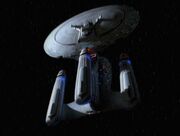
The Enterprise -D in an alternate future
Several alternate versions of the Enterprise -D were seen by Captain Picard after encountering an anti-time eruption in the Devron system . All were part of separate closed timelines.
In the anti-time past of 2363 and 2364 , the Enterprise was not sent to Farpoint Station , but instead was diverted to investigate the anomaly, which was feared to be a new Romulan presence. In this time period, Picard did not inform his crew of his time shifts, worrying that it may influence the future.
He initially ignored Starfleet's orders and proceeded to Farpoint, but then diverted the ship to the Devron system and began scanning the anomaly with an inverse tachyon pulse . When it was discovered that the beam actually caused the anomaly and that the ship would need to create a static warp shell to contain the eruption, the crew was hesitant to accept the orders of their commander, who seemed to be making arbitrary decisions.
After a quick reassurance from Picard, the crew cooperated and the ship joined two other Enterprise s in order to seal the breach. It was the first to be destroyed after the stress from the static warp shell caused a warp core breach.
The second ship existed in the anti-time present of 2370 and 2371. Its history was identical to the real ship up until that point. It was also sent to the Devron system and began to scan the anomaly with the inverse tachyon beam. Picard did tell this crew about his time shifts, and this ship was most drastically affected by the anomaly's effects.
This Enterprise joined the two other ships inside the anomaly, but was also destroyed trying to maintain a static warp shell.
In the anti-time future , the Enterprise was not destroyed at Veridian III, but remained in service for a number of years, Admiral Riker saving the vessel from being decommissioned by making it his personal flagship based out of Starbase 247 .
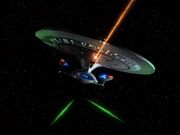
Firing phasers
In this future, the Enterprise had undergone several significant modifications, including the addition of a third nacelle, a cloaking device, and a powerful phaser mounted underneath the saucer section. Riker took the Enterprise to intercept the USS Pasteur when he realized that Picard would investigate the anomaly without permission. It intercepted two Klingon battleships which were attacking the Pasteur , single-handedly destroying one with eight shots from the new phaser weapon. This forced the other vessel to retreat. The Enterprise then rescued the crew of the badly-damaged Pasteur before it was destroyed due to a warp core breach.
Riker ordered the Enterprise back to Federation space, but Picard later convinced him to return to the Devron system and the ship arrived in time to watch the initial formation of the anomaly. It was the last ship to be destroyed when the anomaly was sealed, preventing any of these ships from coming into existence. ( TNG : " All Good Things... ")
Destruction at Veridian III [ ]

The Enterprise destroyed by a shock wave
In yet another alternate timeline, the saucer section of the Enterprise -D was destroyed with the loss of all hands shortly after its crash-landing on the surface of Veridian III. In this version of events, Doctor Tolian Soran successfully launched his trili thium missile into the Veridian star; the resulting shock wave destroyed all planets in the system. Fortunately, before the wave reached the planet, both Soran and Captain Picard were swept into the Nexus, until the Enterprise -D's saucer section and all aboard were wiped out when the shock wave reached Veridian III.
Acquiring the assistance of James T. Kirk , Picard was able to return to a point before Soran launched his weapon and prevent the destruction of the Veridian star, sparing the lives aboard the saucer section of the Enterprise -D at the same time. ( Star Trek Generations )
Appendices [ ]
Appearances [ ].
- " Encounter at Farpoint "
- " The Naked Now "
- " Code of Honor "
- " The Last Outpost "
- " Where No One Has Gone Before "
- " Lonely Among Us "
- " Justice "
- " The Battle "
- " Hide And Q "
- " The Big Goodbye "
- " Datalore "
- " Angel One "
- " 11001001 "
- " Too Short A Season "
- " When The Bough Breaks "
- " Home Soil "
- " Coming of Age "
- " Heart of Glory "
- " The Arsenal of Freedom "
- " Symbiosis "
- " Skin Of Evil "
- " We'll Always Have Paris "
- " Conspiracy "
- " The Neutral Zone "
- " The Child "
- " Where Silence Has Lease "
- " Elementary, Dear Data "
- " The Outrageous Okona "
- " Loud As A Whisper "
- " The Schizoid Man "
- " Unnatural Selection "
- " A Matter Of Honor "
- " The Measure Of A Man "
- " The Dauphin "
- " Contagion "
- " The Royale "
- " Time Squared "
- " The Icarus Factor "
- " Pen Pals "
- " Samaritan Snare "
- " Up The Long Ladder "
- " Manhunt "
- " The Emissary "
- " Peak Performance "
- " Shades of Gray "
- " Evolution "
- " The Ensigns of Command "
- " The Survivors "
- " Who Watches The Watchers "
- " The Bonding "
- " Booby Trap "
- " The Enemy "
- " The Price "
- " The Vengeance Factor "
- " The Defector "
- " The Hunted "
- " The High Ground "
- " A Matter of Perspective "
- " Yesterday's Enterprise "
- " The Offspring "
- " Sins of The Father "
- " Allegiance "
- " Captain's Holiday "
- " Tin Man "
- " Hollow Pursuits "
- " The Most Toys "
- " Ménage à Troi "
- " Transfigurations "
- " The Best of Both Worlds "
- " The Best of Both Worlds, Part II "
- " Brothers "
- " Suddenly Human "
- " Remember Me "
- " Reunion "
- " Future Imperfect "
- " Final Mission "
- " The Loss "
- " Data's Day "
- " The Wounded "
- " Devil's Due "
- " First Contact "
- " Galaxy's Child "
- " Night Terrors "
- " Identity Crisis "
- " The Nth Degree "
- " The Drumhead "
- " Half a Life "
- " The Host "
- " The Mind's Eye "
- " In Theory "
- " Redemption "
- " Redemption II "
- " Ensign Ro "
- " Silicon Avatar "
- " Disaster "
- " The Game "
- " Unification I "
- " Unification II "
- " A Matter Of Time "
- " New Ground "
- " Hero Worship "
- " Violations "
- " The Masterpiece Society "
- " Conundrum "
- " Power Play "
- " The Outcast "
- " Cause And Effect "
- " The First Duty "
- " Cost Of Living "
- " The Perfect Mate "
- " Imaginary Friend "
- " The Next Phase "
- " The Inner Light "
- " Time's Arrow "
- " Time's Arrow, Part II "
- " Realm Of Fear "
- " Man Of The People "
- " Schisms "
- " Rascals "
- " A Fistful of Datas "
- " The Quality of Life "
- " Chain Of Command, Part I "
- " Chain Of Command, Part II "
- " Ship In A Bottle "
- " Face Of The Enemy "
- " Tapestry "
- " Birthright, Part I "
- " Birthright, Part II "
- " Starship Mine "
- " Lessons "
- " The Chase "
- " Frame of Mind "
- " Suspicions "
- " Rightful Heir "
- " Second Chances "
- " Timescape "
- " Descent "
- " Descent, Part II "
- " Liaisons "
- " Interface "
- " Gambit, Part I "
- " Gambit, Part II "
- " Phantasms "
- " Dark Page "
- " Attached "
- " Force of Nature "
- " Inheritance "
- " Parallels "
- " The Pegasus "
- " Homeward "
- " Sub Rosa "
- " Lower Decks "
- " Thine Own Self "
- " Eye of the Beholder "
- " Genesis "
- " Journey's End "
- " Firstborn "
- " Bloodlines "
- " Emergence "
- " Preemptive Strike "
- " All Good Things... "
- DS9 : " Emissary "
- Star Trek Generations
- ENT : " These Are the Voyages... "
- " Remembrance " (dream only)
- " Maps and Legends " (hologram only)
- " The Next Generation " (model)
- " The Last Generation "
- LD : " Trusted Sources " (display graphic, mural)
- " Starstruck " (digital image)
- " Kobayashi " (hologram)
- VST : " Worst Contact "
Background information [ ]
The Enterprise -D model was designed by Andrew Probert . The basic layout of the ship was derived from a painting Probert had done following Star Trek: The Motion Picture of how he would redesign the Enterprise had he been allowed to break with the basic plan Matt Jefferies and Joe Jennings created for Star Trek: Phase II . When he was hired to work in the Star Trek: The Next Generation art department, he brought the painting with him and hung it in his office, then set to work on the design of the bridge. Out of pure luck, David Gerrold saw the painting and brought it to Gene Roddenberry 's attention. Roddenberry immediately approved the general direction. Probert further refined the design into the familiar shape; however, he originally conceived the battle section as a smaller vessel shaped like a "D" which detached from an area on the saucer. Later, the producers informed him that they wanted the ship to split in two and have the engineering hull serve as the battle section. This presented an additional problem for Probert, as he needed to figure out some way to fulfill the producers' requests while keeping the original lines of the design. Eventually, he found a way to incorporate a separation using the approved design, and after several more minor changes, the design reached its final form. Roddenberry's only requests were to lengthen the ends of the warp nacelles and to keep the bridge on the top of the saucer section rather than within the ship. Roddenberry felt that having the bridge on the exterior gave a sense of scale to the vessel.
Two versions of the filming miniature were built by Industrial Light & Magic (ILM) for the first season : a large six-foot model and a smaller less-detailed two-foot model, both constructed under the supervision of Ease Owyeung . Both were capable of saucer separation. The cost to construct the original models was US$75,000. For the third season , Greg Jein built a new four-foot miniature. It was not built to separate, but for the first time it accurately depicted the Ten Forward windows. It first appeared in TNG : " The Defector " and completely replaced the previous two models, although stock footage of the original models was still used. The six-foot model was briefly reused for the saucer separation in " The Best of Both Worlds, Part II ". It was completely refurbished and overhauled for Star Trek Generations , where it represented the Enterprise alongside a computer-generated version and a special twelve-foot-wide saucer, created for the crash sequence. ILM crewmember Bill George relabeled the registry on the saucer to "NCC-1701-E" before the model was returned to the Paramount archives. The four-foot model was modified into the three-nacelled Enterprise from " All Good Things... " and later partially restored to become the USS Odyssey in " The Jem'Hadar " and the USS Venture in " The Way of the Warrior ".
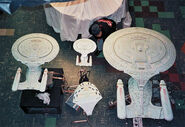
The original six-foot filming model of the Enterprise -D (Lot #712) was sold at the 40 Years of Star Trek: The Collection auction on 7 October 2006 for US$576,000, including the buyer's premium (the winning bid was US$500,000), by far the highest price for any item in the auction.
The Star Trek Generations CGI model was utilized as various Galaxy -class ships during Star Trek: Deep Space Nine and Star Trek: Voyager . This same CGI model was overhauled by Gabriel Koerner for the ship's appearance in " These Are the Voyages... ".
During the early planning stages of TNG, it was intended for the series to be set in the late 25th century . The Enterprise -D would have been the seventh starship to bear the name, with a registry of NCC-1701-7. After the release of Star Trek IV: The Voyage Home featuring the USS Enterprise -A , the designation was changed to NCC-1701-G before the producers finally moved the series to eighty years after Star Trek: The Original Series and settled on NCC-1701-D. There was also talk of eliminating the starship from the TNG series altogether and merely boosting the abilities of the transporter, but this idea was quickly dropped.

Conceptual sketch for the Enterprise bridge by Andrew Probert
Interior sets were supervised by Herman Zimmerman during the first season and Star Trek Generations . Andrew Probert also contributed design sketches, most importantly for the bridge. Richard James took over the role from the second season until the end of the series. Many sets were recycled from those created by Harold Michelson for Star Trek: The Motion Picture and the aborted Star Trek: Phase II . In turn, many of the Enterprise -D sets were transformed into those of the USS Voyager for Star Trek: Voyager .
Parts of the Enterprise -D sets, including the bridge tactical station, command chairs, and main engineering master systems display were displayed at the Hollywood Entertainment Museum [4] until they shut down in 2007, at which time the items were returned to Paramount. Other smaller set pieces and walls have been kept in the Paramount archives and used in other Star Trek productions, even becoming parts of the recreated TNG sets in "These Are the Voyages...".
A design patent was issued in 1990 for the "ornamental design" of the Enterprise -D. Andrew Probert was recognized in that patent as the sole "inventor" of the design.
The Enterprise -D had a captain's yacht named the Calypso . It was never actually seen, due to budget restrictions, but it can be seen on the underside of the saucer section. ( Star Trek: The Next Generation Technical Manual )
In a scene description from the final draft script of ENT : " These Are the Voyages... ", the Enterprise -D was referred to as a "great ship".
Apocrypha [ ]
Reference manuals [ ].
The Enterprise -D was the subject of the highly detailed Star Trek: The Next Generation Technical Manual by Rick Sternbach and Michael Okuda , and had its sets rendered in QuickTime VR for the interactive version of the book.
Sternbach later produced a set of blueprints depicting every single deck of the Enterprise .
The Enterprise -D was seen in several officially-licensed games , including Star Trek: The Next Generation - A Final Unity , Star Trek: The Next Generation - Echoes from the Past , and Star Trek Generations . It also made a brief appearance at the end of the Star Trek: Armada strategy game, and in a Star Trek: Legacy mission with the USS Defiant .
Attractions [ ]
The Enterprise -D met the science vessel Antares at the conclusion of Star Trek: Orion Rendezvous , a Star Trek -themed planetarium show produced in 1992 in conjunction with the Star Trek: Federation Science exhibit. That exhibit featured displays and interactive learning games modeled after the Enterprise -D bridge, engineering, sickbay, science lab, and transporter room.
Until September 1st, 2008, fans could visit the Enterprise -D via Star Trek: The Experience , which took guests through the transporter room, corridors, bridge, and shuttle deck while attempting to escape into a temporal rift aboard a shuttle motion simulator ride. Similar recreations of certain sets were included in the European Star Trek World Tour . [5]
External links [ ]
- USS Enterprise (NCC-1701-D) at StarTrek.com
- USS Enterprise (NCC-1701-D) at Memory Beta , the wiki for licensed Star Trek works
- USS Enterprise (NCC-1701-D) at Wikipedia
Overcharged Warp Core
- VisualEditor
- View history
The Overcharged Warp Core is a type of Warp Core that increases the maximum capacity of a ship's Auxiliary Power setting.
Item Description [ | ]
The Overcharged Warp Core increases a ship's maximum Auxiliary Power setting by +5, allowing a maximum of 130 to Auxiliary.
Acquisition [ | ]
Warp Cores can be acquired either as drops in combat, through Duty Officer Assignments, on the Exchange , or from Fleet Vendors.
Log in or Sign up
You are using an out of date browser. It may not display this or other websites correctly. You should upgrade or use an alternative browser .
Warp Drive Energy Consumption Efficiency and scaling to TransWarp speeds.
Discussion in ' Trek Tech ' started by KamenRiderBlade , Oct 8, 2021 .
KamenRiderBlade Rear Admiral Rear Admiral
So based on my Warp Factor 3.0 Scale data from my Spread Sheet Which is just TNG era Warp Factor formula without the stupid hand drawn curve to infinity past Warp 9. I just uncap that formula and let it properly run to infinity via the Spread Sheet which gives you a handy dandy table to work with. I noticed that the power consumption generally creeps up pretty dramatically and why StarFleet and the UFP needed to find alternate ways of FTL if they want to hit TransWarp speeds. Here's the TOS era version of this Warp Factor Scale: Here's the TNG era version: Below is my own hand made expanded version of Warp Factor & Power Consumption Scale. To give you a sense of scale, according to Tom Paris' on screen stated evidence of Warp Factor 9.9 being: " How fast? " " Warp 9.9. In your terms, that's about four billion miles a second. " " Think I could take her out for a spin? " " Well, uh... " - Amelia Earhart and Tom Paris , on Voyager in ST:VOY.S2.E01 - The 37's On my revised Warp Factor scale, the TNG era Warp Factor 9.9 is some where between Warp Factor 20 & 21, basically Warp Factor 20.###. ============================================================ TOS Era = Warp Factor Scale (Version 1.0). TNG Era = Warp Factor Scale (Version 2.0). Here's my terminology. On my Warp Factor Scale (Version 3.0): + Here are the general Warp Factor Speed ranges: - Warp Factor 1-9.# = Basic Warp Speed range (100% Backwards Compatible with TNG-era Wf 1-9) - Warp Factor 10-99.# = Decka Warp Speed range - Warp Factor 100-999.# = Trans Warp Speed range - Warp Factor 1,000 - 9,999.# = Super Warp Speed range - Warp Factor 10,000 - 99,999.# = Hyper Warp Speed range - Warp Factor 100,000 - 999,999.# = Ultra Warp Speed range. - Anything ≥ Warp Factor 1,000,000.#; we'll just stick with Metric Prefix based Warp Speeds at that point. ============================================================ To give you and idea as to how much power the Warp Reactor can output, the Galaxy Class has a power output of: 12.75 EW: In 2369, the generation of 12.75 Billion GigaWatts (12.75x10^12 MW) of energy was harnessed (over an unspecified time period) in the warp core aboard a Galaxy-class starship. (ST:TNG.S6.E06) The exact quote: AMANDA: It's hard to imagine how much energy is being harnessed in there. DATA: Imagination is not necessary. The scale is readily quantifiable. We are presently generating twelve point seven five billion gigawatts per (an alarm goes off) That's ALOT of MegaWatts, for scale / reference: One single large Wind Turbine has a average Power Generation of 1.67 MW in the 21st Century in the US. And the Warp Reactor of the Enterprise-D can generate (12.75x10^12 MW). ============================================================ But as you scale up, you notice on my chart that I modified to show more data, that base power consumption is generally measured in MegaWatts. And as you creep up the Warp Scale, you're running into the Total Power Generation Limits of a Galaxy Class Warp Reactor. Even assuming the USS Voyager / Intrepid-Class was more advanced and had a more compact reactor that can generate the same level of Power Output as the Galaxy Class, the UFP needed to start looking for alternate FTL methods that traveled faster, farther, for less power consumption. Scaling up past Warp 9.9 (TNG era) or Warp Factor 20 really starts consuming a VERY HIGH % of your Total Reactor Output Budget 10^9 class of power consumption when your total Max Output is in the 10^12 range. I did the math with the USS Equinox and it's Enhanced Warp Drive that used the carcasses of that interdimensional alien, and they were in the Warp Factor 43 speed range, but that puts your power consumption levels at 10^10 -> 10^11 MW power consumption range, no wonder he had to murder so many of those poor Inter Dimensional creatures if their carcasses can generate that much power. It seemed like the USS Equinox's main issue besides being beaten up & heavily damaged was the Warp Core/Reactor Power Generation Issue; not their Warp Nacelles or Space Frame being incapable of handling those extreme speeds. So as you scale up and go faster using Traditional Warp Drive (Assuming your Space Frame & Warp Engines can handle it), you need that much more Warp Core / Reactor Power if you use Traditional Warp Drive. Obviously, if you were using Vulcan Coleopteric Warp Rings, you can save ~17% on your power consumption, but you lack tactical manueverability at Warp Speeds. StarFleet wouldn't want that, especially given that it gets into FTL battles at Warp Speed often enough that it needs to be considered. But, a regular civilian operation would want it for Energy Efficiency Savings alone. So they might consider designing or building vessels around Vulcan Warp Rings / Coleopteric Warp Drives. I wouldn't be surprised if we see more Non-Vulcan / UFP civilian vessels use Warp Rings due to it's energy efficient nature while operating at Warp Speeds. 17% of that big of a power consumption level is HUGE. That could affect your resource costs as well and how long you would need to refuel. Even USS Voyager's Un-Scheduled 70,000 ly journey from the Delta Quadrant to home: - Based on the on-screen estimates of 75 year journey has a average cruise speed of Warp 8 assuming unlimited fuel - Warp 8 would take 68.36 years if non-stop with unlimited fuel, but given stops, repairs, exploration, etc. They probably rounded up to 75 years - That means I can guess that Warp 8 was their cruise speed assuming unlimited fuel (A VERY Unrealistic Scenario) - Galaxy Class initial Average Cruise speed was Warp 6, but later on became Warp 7. - Intrepid Class should be one Warp Factor tier above the Galaxy Class for Cruise Speeds, especially given how much more advanced technologically the Intrepid Class was over the Galaxy Class. - But I highly doubt that the USS Voyager had enough Fuel / Supplies for that long of a journey. They were supposed to be back to DS9 in a few weeks, so I doubt they packed that many resources onto the USS Voyager, ergo lack of Fuel / Supplies. So I'm not really surprised that the UFP / StarFleet are looking for a more efficient way of FTL that is also faster (TransWarp Drives). Quantum SlipStream and Borg TransWarp Corridor Generators are very interesting technologies considering they require different tech and principles to operate. The base power consumption could be ALOT better (More Energy Efficient) than traditional Warp Drive IMO, especially for the given speed that they're going and how much power a traditional Warp Drive would need just to match the QSS & TWCG speeds. Any thoughts on my napkin analysis?
LazyReader Lieutenant Red Shirt
I tried to calculate this a while ago. As for energy consumption, put into effect ships available power. All federation ships warp capable are powered by a Matter/antimatter reactor assembly (M/ARA) since specific fuel consumption is rarely mentioned in Lore, we don't simply know. But we do know! Matter-antimatter reactions produce huge volumes of energy. 180 Petajoules per kilogram consumed. Conversion efficiency is seldom mentioned except in one episode. In TNG episode "Force of Nature" USS Intrepid (intrepid class) managed to get a power conversion efficiency of 97.1% suggesting 97.1% of the energy generated by it's warp core is available power or 174.78 Petajoules per kilogram consumed. The CLOSEST thing we get is the "TNG" technical manual which states fuel tankage size; In said Apocrypha Galaxy class carries 62,500 cubic meters of Slush deuterium with a density of 86.51 kg per meter; the ship carries over 5,400 metric tons (Assuming they don't compress it to even higher densities), enough for "Three Years" since the antimatter matter mix ratio is always 1:1 and the ship carries 3000 cubic meters of slush Anti-deuterium or 259.53 tons/259,530 kilograms, given the inferior volume of anti-matter aboard; , the ship can produce it's own antimatter (using it's own fuel at significant expense if need be), we'll give rough estimate of one years anti-matter fuel supply. Full antimatter consumption with a 97.1% conversion efficiency of useful power, would produce 45.36 Zettajoules in a year under ideal conditions. Divided by 8,766 hours in a year using 29 kilograms per hour and an energy output of at least 5.0686 Exajoules per hour (1.437 Billion kilowatt-hours) or 1.40795 Petajoules a second, a Joule per second is a Watt of power so engine under ideal conditions produces 1.40795 Petawatts. Add on top of that Ships Impulse engines (Giant fusion reactors) and auxiliary fusion reactors as backups. Standard cruising velocity of warp 5-6, Ship uses about 29 kg per hour or 8 grams per second. But a galaxy class uses more fuel than a faster but smaller Intrepid. Like All propulsion technologies, mass and fuel are variable. A 30 foot boat with a Mercury 150 horsepower engine uses 15 gallons of fuel per hour. An Arleigh burke destroyer uses 1000-2000 gallons of fuel per hour. A ships warp core runs whether it's traveling at warp or not. So assuming 8 grams is sufficient for casual warp velocity (warp 5), Warp 6 uses more, and so on Transwarp fuel consumption
Dumbbell Lieutenant Commander Red Shirt
I think warp drive research and development, especially within the Federation, should focus on making warp engines the best in class at Warp Factor 5, and reducing damage to space/time thus permitting regular use at speeds greater than Warp Factor 5. Sometimes you have to take a step back to take two steps forward.
Dumbbell said: ↑ I think warp drive research and development, especially within the Federation, should focus on making warp engines the best in class at Warp Factor 5, and reducing damage to space/time thus permitting regular use at speeds greater than Warp Factor 5. Sometimes you have to take a step back to take two steps forward. Click to expand...
What’s your take on transwarp? I mean the real transwarp: tactical transwarp. The one that Captain Lawrence H. Styles, of the prototype transwarp vessel, U.S.S. Excelsior , was going to engage in pursuit of James T. Kirk aboard the stolen U.S.S. Enterprise . The one that the U.S.S. Enterprise , NCC-1701-A, formerly U.S.S. Yorktown , also had. The one that also mysteriously vanished from both vessels in a hurry and virtually disappeared from memory… Failed experiment, my asterisk!
Timo Fleet Admiral Admiral
(FWIW, the Enterprise -A never did have transwarp. While computer display graphics to that effect were seen in a certain backstage book, the actual set never featured those exact graphics, or more accurately those exact texts; the word "warp" in the original Okudagrams was just changed to "transwarp" by the author of the book.) Timo Saloniemi
No, the U.S.S. Enterprise , NCC-1701-A, did not have the transwarp tactical system. It was the U.S.S. Yorktown . By the time our heroes took command of the Enterprise , formerly Yorktown , the tactical transwarp system had been removed along with the former registries. It was a conspiracy, I tells ya!
Dumbbell said: ↑ What’s your take on transwarp? I mean the real transwarp: tactical transwarp. The one that Captain Lawrence H. Styles, of the prototype transwarp vessel, U.S.S. Excelsior , was going to engage in pursuit of James T. Kirk aboard the stolen U.S.S. Enterprise . The one that the U.S.S. Enterprise , NCC-1701-A, formerly U.S.S. Yorktown , also had. The one that also mysteriously vanished from both vessels in a hurry and virtually disappeared from memory… Failed experiment, my asterisk! Click to expand...
That's cool, but that's exactly what they want you to believe! (They don't want you to discover the secret weapons of the transwarp development project. )
Dumbbell said: ↑ That's cool, but that's exactly what they want you to believe! (They don't want you to discover the secret weapons of the transwarp development project. ) Click to expand...
It looks like you are thinking in terms of “transwarp” being just another name for a better, faster warp drive. To me, that is clearly a fiction within a fiction. Why the Federation generated such a fiction was never disclosed in canon. It seems obvious to me, however, that Captain Scott’s timely sabotage afforded the perfect opportunity to redact and seize all transwarp-related technology. True transwarp is not just another name for a better, faster warp drive. But never mind all that! I like your idea of adjusting the scale in the name of efficiency so that we no longer have to refer to advanced (but now very common) warp speeds in terms of Warp Factor 9-point-something… I'd go for something like Warp Factor x where x is equal to ((x to the xth power) times the speed of light).
Dumbbell said: ↑ I'd go for something like Warp Factor x where x is equal to ((x to the xth power) times the speed of light). Click to expand...
- Log in with Facebook
- No, create an account now.
- Yes, my password is:
- Forgot your password?
- Search titles only
Separate names with a comma.
- Search this thread only
- Display results as threads
Useful Searches
- Recent Posts
- The Original Series
- The Animated Series
- The Next Generation
- Deep Space Nine
- Strange New Worlds
- Lower Decks
- Star Trek Movies
- TrekCore on Twitter
- TrekCore on Facebook

Commander Rayner (Callum Keith Rennie) isn’t thrilled by this prospect, pointing out before she leaves that it’s too dangerous a mission for a captain to undertake. But Burnham disagrees that this is enough of a reason to stop her; it’s a nice reminder that this is a show and a character that originated in the time of James T. Kirk, a time when captains didn’t stay behind in the face of danger.
But it’s not only that, there’s something else going on. Burnham gives Rayner permission to be blunt, quoting a classic work on Rayner’s native Kellerun , The Ballad of Krull , asking him to “serve it without a crumb of ossekat .” (As far as made-up Star Trek idioms go, that’s a pretty good one.)
It’s also the beginning of a sudden and relentless onslaught of references to Rayner’s culture, but more on that later. What’s Rayner’s problem? He’s uncomfortable with the prospect of being left in command of a ship and crew that aren’t “his.” Welcome to being second in command, buddy.
Book and Burnham take off, heading into the wormhole and finding it to be an inhospitable place. They quickly drop out of communication range with Discovery , there’s ship debris everywhere, including the wreckage of Moll and L’ak’s ship…. and what’s that, the ISS Enterprise ?!
(A side note before we get too excited about that: what is the deal with all the empty space in the new shuttlecraft set, introduced in last season’s “All Is Possible”? The two pilot seats looked like they were crammed into the corner of a huge unfurnished room.)
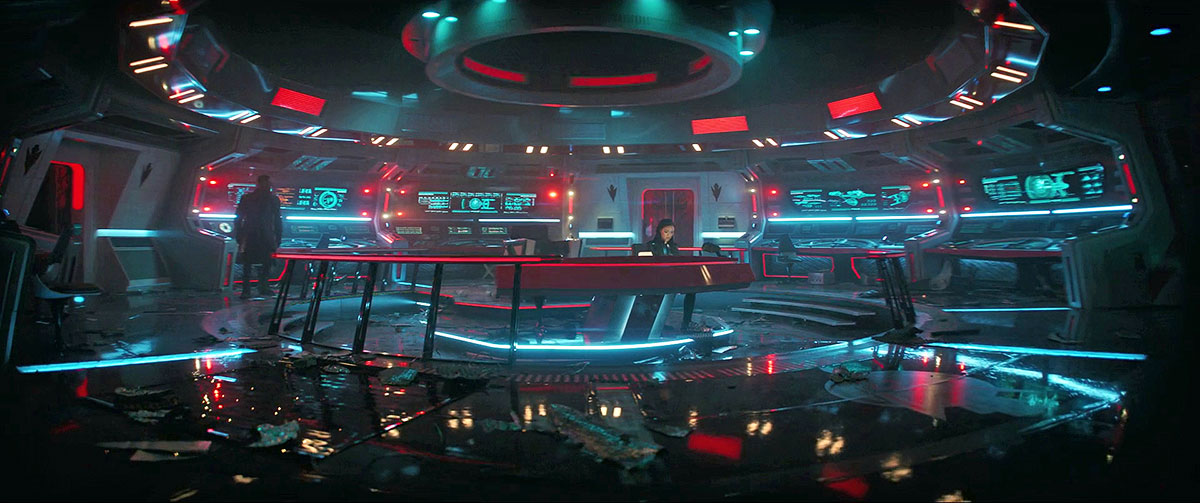
Okay, Enterprise time. Burnham and Book rightly surmise that this is where Moll and L’ak must have escaped to and beam to the ship, which of course turns out to be a redress of the Strange New Worlds standing sets. A quick scan identifies that no one else is aboard — though the clue, which Moll and L’ak have found, does also have a lifesign, hmm — and that Moll and L’ak are holed up in sickbay. Burnham takes a few moments to ponder her visit to the Mirror Universe back in Season 1 and wonder what the alternate version of her half-brother Spock might have been like (bearded, for one).
And aside from some brief storytelling about Mirror Saru’s role as a rebel leader, that’s about it for the Terran Empire of it all. Star Trek: Discovery has spent plenty of time in and around the Mirror Universe already, and I personally don’t think they need to revisit it again. But introducing the ISS Enterprise — the ship that started it all with The Original Series ’ “Mirror, Mirror” — and then not doing anything momentous with it? Strange decision, and one that makes it ultimately feel more like this was a way for the show to get to reuse a set on the cheap than it does a materially significant addition to the episode.
In fact, in some ways it’s actually a detriment to the episode. If the action had been set on any other ship it would have been fine, but being on the ISS Enterprise I kept expecting something — like seeing Paul Wesley as Mirror Kirk slinking around, or finding Anson Mount camping it up as Mirror Pike in a personal log. If they’d set the action on a generic derelict ship, what we got wouldn’t have seemed like a let down. As it is though, I kept waiting for the other shoe to drop… and it simply never did.
Maybe in a subsequent episode, it’ll turn out that there’s an advantage in having an entire functional starship composed of atoms from another universe at Starfleet’s disposal — or to have a convenient collection of Constitution -class sets available for that Starfleet Academy show to borrow once in a while — but until that happens (if it even does) the use of the ISS Enterprise just seems like a name drop and a “We have to set the action somewhere , why not here?” instead of a significant use of the setting and the huge amount of lore and history that comes with it.
It’s like setting something aboard the Titanic without ever mentioning any icebergs.
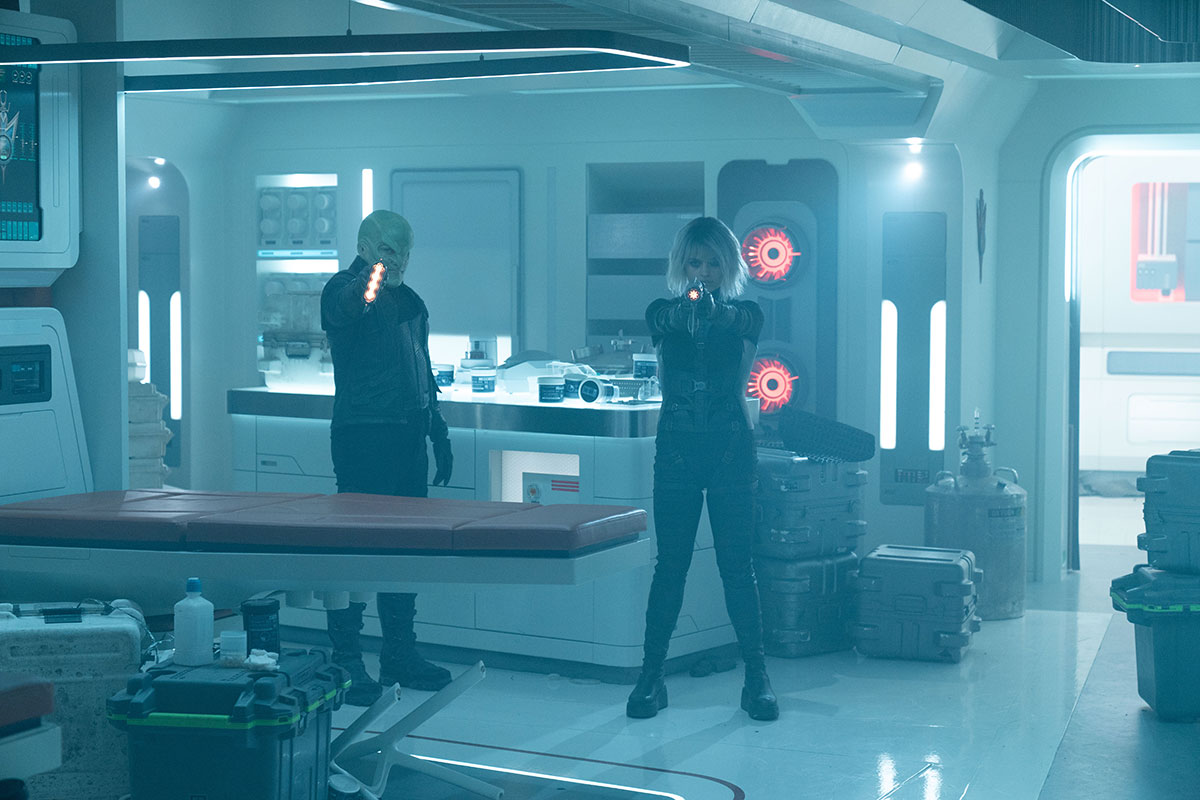
As Burnham and Book make their way down to sickbay they do find evidence that the ship was being used in a way that seemed unusually gentle for a Terran Empire vessel: signs that children and families were aboard at one time, and that they were the kind of people sentimental enough to have keepsakes and favorite stuffed animals. But again, nothing about this seems like it needs the Mirror Universe connection. Ships of people trying to escape adversity are already a Star Trek staple.
Burnham and Book find Moll (Eve Harlow) and L’ak (Elias Toufexis) in sickbay, and after a valiant but ultimately unsuccessful attempt at getting them to surrender, everyone starts shooting. Moll and L’ak have a Breen blood bounty — an erigah — on their heads and surrender is simply not an option. During the firefight a lockdown is triggered, forcefields coming down that split the group into pairs: Burnham and L’ak stuck in sickbay, while Book and Moll able to go back to the bridge to try and reset sickbay.
Pairing off also gives Book the opportunity to continue his efforts to connect with Moll, and I have to say, I don’t think I’m a fan. Setting aside the portion of this that’s purely a strategic attempt to forge a connection with someone who is very to keen to kill him, my first reaction to the way Book talks to Moll about her father (and his mentor) was distaste.
I don’t think Book meant it this way, but the way he’s written in these scenes feels unpleasantly close to the “Well, he was a great guy to me , I never saw him do anything bad” response that’s sometimes made to accusations of misconduct. A person can be wonderful to some people in their life and terrible to others; both experiences are true for the people who received them, but they’re not mutually exclusive.

Book is preternaturally empathetic, and yet he doesn’t seem to see how continually assuring Moll that her father loved her is an act that’s both unwanted and actively painful for Moll to hear. I understand that Book is just trying to bring a sliver of comfort to Moll – but in the process he’s dismissing her own experiences of her father and his place in her life. Unless Moll asks him for this, it’s really none of Book’s business.
I suspect they’re setting up Moll’s character for a nice, cathartic arc where she comes to terms with her life, forgives her father, releases her past, whatever. And when that happens in real life that’s great — but it doesn’t always, and that’s okay too. If Moll never sees in her father the man Book saw in his mentor, it’s not a character failing. Discovery is really hammering home the theme of confronting one’s past in order to take control of one’s present and future, and I think it would be valuable if they included an example of a character learning to do the latter… without having to be okay with the former.
And to return to a question I posed in my review of “Under the Twin Moons,” I know Book is isolated and excruciatingly lonely after the destruction of Kweijan and his split with Michael, but the weight he’s placed on his relationship with Moll as “the closest thing he has to family” seems like he’s setting himself up for disappointment. Maybe I’m just a cynic, but this does not feel like a hopeful storyline to me. Not everyone wants to be family, and right now it doesn’t seem like Moll’s been given much of a choice in the matter — despite her frequent and very powerful explanations of why she’s not interested.
Clearly frustrated with Book’s topic of conversation and desperate to return to L’ak, Moll makes a reckless decision to brute-force a solution and overload some circuits. It works, and the forcefields in sickbay come down, but it also sends the Enterprise onto an unstoppable collision course with the too-small-to-pass-through and also going-to-be-closing-forever-soon wormhole. They’ve got eight minutes to figure this out.

Meanwhile aboard Discovery , we see Rayner’s struggles to interact with the crew. This thread could have gone so many different ways, Rayner seeming “too good” for a temporary command, him seeing this as his chance to do things “better” than Burnham or show how it’s “really done,” but instead the show takes the much more subtle and satisfying route: Rayner is deeply respectful of the captaincy, as a rank and a role, and really doesn’t want to step on Burnham’s authority.
He’s more than willing to disagree with her on command decisions , but he doesn’t question her command . And more personally, he doesn’t want his gruffness and lack of experience with this crew to cause problems. He’s trying, in his own Rayner way, and more importantly he’s succeeding — and, as we see as he shepherds the crew through figuring out how to communicate with and then rescue Book and Burnham, the crew does their part and meets him halfway.
Rayner is learning that he needs to tone down his temperament just enough that he doesn’t come across as an actual asshole to this crew, and the crew is learning that his gruffness isn’t a sign of disrespect but simply a desire to cut to the chase and get to direct, actionable information with a minimum of fluff. There are shades of Nimoy’s Spock or Voyager -era Seven of Nine here, but couched within a distinctly different temperament, and it’s fascinating to watch. I’d love to have seen him interacting with the crew of the Antares , where he presumably felt more comfortable.
The interpersonal stuff with Rayner and the crew is great; where Rayner’s thread feels distractingly like a box being checked is the explosion of “Rayner is a Kellerun!” being shouted from the bulkheads. I could practically hear the writers yelping out a panicked “Oh crap, we forgot to say what kind of alien Rayner is!”
Again, Discovery is back to its old self with the clunky, heavy-handed, and oddly paced character work. Rayner goes from having zero cultural touchstones to having about five in the span of the 15-20 minutes of screentime that his story gets this week. They’re good touchstones, don’t get me wrong — I’m skeptical of Kellerun citrus mash, I have to be honest, but I’d give it a try; not so sure about boiling a cake though — they’re just very present .
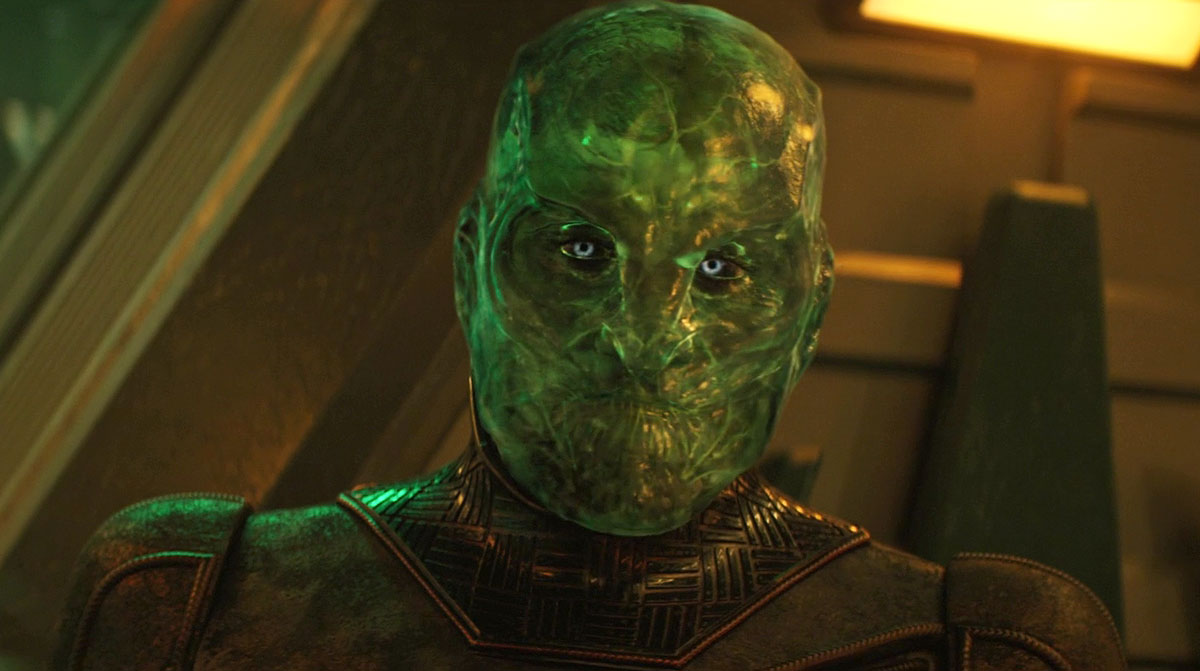
As with Rayner’s alienness, the frequent flashbacks throughout the episode to Moll and L’ak’s meeting and courtship feel like a “We forgot to explain this and now we’re trying to reference it!” correction. The content of the flashbacks is fine, there’s a lot of interesting Breen worldbuilding for a species that’s been mysterious from the start — and watching Moll and L’ak’s relationship grow from one of mutual convenience to one of true love is genuinely moving. But the way it’s woven into an episode that, again, feels like it’s composed of bits and pieces of storyline, makes it hard to shake the sense that I was watching a To Do list get checked off.
By the time the season is over it might be clear that there was simply no extra room to give a full episode over to Moll and L’ak’s meeting, or maybe an episode without any of the main cast wasn’t something they were willing or contractually able to do, but I would have loved if these flashbacks were pulled out and expanded into a full-length episode of their own. Some of the worldbuilding felt hasty to the point of hindering the emotional beats — at times I wondered if I’d forgotten a whole bunch of Breen lore and at others I was just trying to keep up with what was going on.
For example, my confusion about L’ak’s comment about having two faces, which Moll seemed to completely understand — “Duh, everyone knows the Breen have two faces” — was a distraction in the middle of an otherwise nice and significant moment. This is later clarified as the translucent face and the solid face, but again I was distracted from fully appreciating an interesting bit of Breen culture because I was busy applying what I’d just learned back to the previous scene.
The quickly (and maybe not totally clearly articulated notion) that Breen deliberately restrict themselves to their translucent form for reasons that are entirely to do with avoiding any perception of weakness is a potent if hasty bit of social commentary, and as I said I nearly didn’t catch it.
Whether holding the translucent form requires the armor for protection or the armor necessitates the translucent form — it seems like it would be more comfortable wearing that helmet all the time if you were the texture and consistency of lime jello — this is surely a metaphor for the increasingly rigid, isolating, and emotionally and sometimes physically unhealthy things men in certain circles feel they must do to be appropriately masculine. Seeing L’ak free himself from that rigidity is powerful.
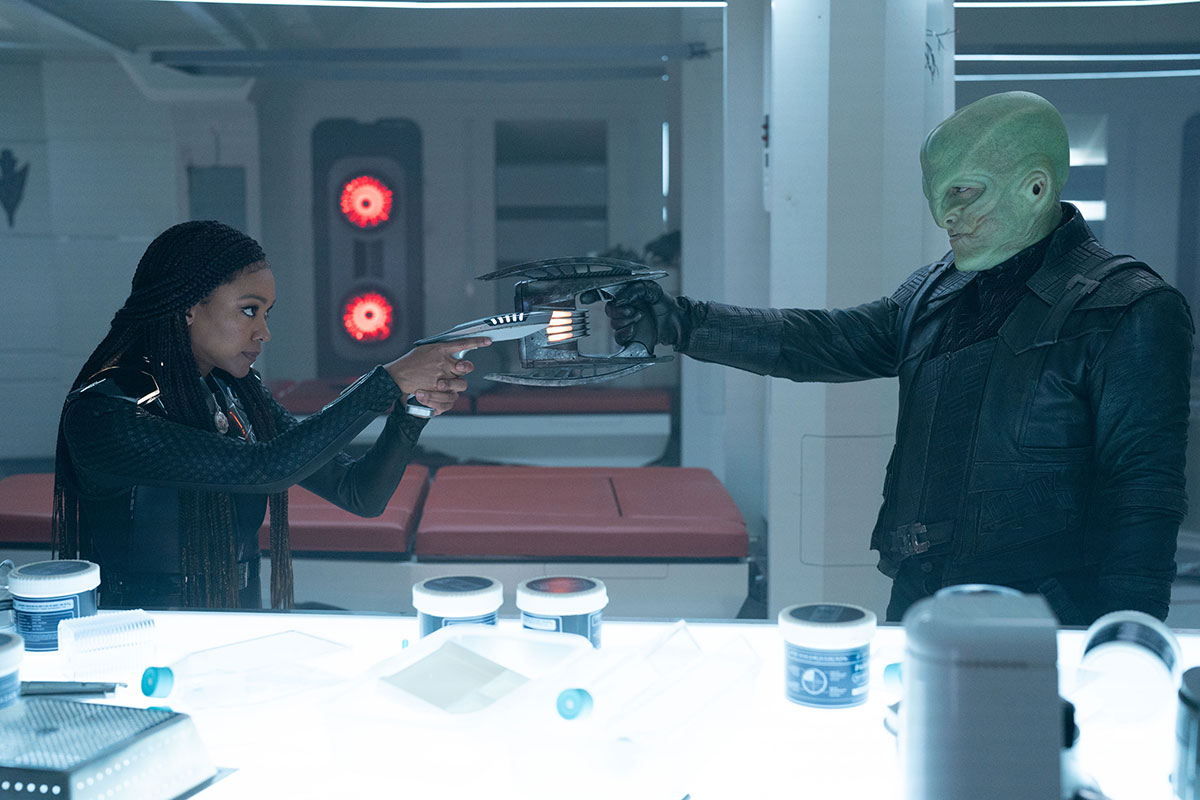
With the forcefields in sickbay down, Burnham and L’ak immediately spring into action: Burnham trying to get the artifact from L’ak and L’ak simply trying to get away. They fight, and Burnham impressively proves she can hold her own against a Breen. When L’ak accidentally falls on his own blade, Burnham grabs the clue and speeds to the bridge where she manages to get a message to Rayner through some tractor beam trickery. The message? Another reference to that classic of Kellerun literature that gives Rayner the info he needs. Hey, did you know Rayner was a Kellerun?
The ISS Enterprise makes it through the wormhole, Moll and L’ak zip away in an escape pod, and it’s time to wrap things up. We head to Red’s for a quick but significant moment between Tilly (Mary Wiseman) and Culber (Wilson Cruz), as Tilly offers advice and an ear to a Culber who’s going through a quiet existential – maybe also spiritual? – crisis.
OBSERVATION LOUNGE
- In addition to the dedication plaques on the bridge, the ISS Enterprise has an additional plaque in its transporter room — one which, despite recounting the heroism of rebel action hero Mirror Saru, still states “Long Live the Empire.”
- The transporter room plaque is marked with “Stardate 32336.6,” which is about 9 years before the events of “Encounter at Farpoint.”
- The plaque describes the fate of Mirror Spock, who was killed after instituting the reforms which later led to the fall of the Terran Empire (as described in DS9’s “Crossover”).

The full text of the ISS Enterprise transporter room plaque:
The new High Chancellor presented hope and justice as if they were natural to our world. His words, “The light of hope shines through even the darkest of nights” became our rallying cry. He spoke of reform, and changed many of us. But some saw this as weakness. They killed him, and we sought help from an unlikely ally: A Kelpien slave turned rebel leader. He spoke of visitors from another world… a near perfect [inspiration?] cast our darkness into light. With his aid we secured the Enterprise and stayed behind to continue his work. We bear scars from our escape, but our hope remains. May it carry us into a [pristine?], peaceful, and [?] future.
- Not counting L’ak’s previous appearances this season, this episode marks the first time we have seen the Breen in live action since their involvement in the Dominion War in Deep Space Nine. (The species has appeared in Star Trek: Lower Decks three times.)
- The 32nd century Breen wear updated encounter suits clearly based on the designs introduced in Deep Space Nine ; their digital speech is extremely faithful to the incomprehensible noises Breen soldiers have spoken in past appearances.
- Given the fact that Moll appears to be just fine in the environment of the Breen ship, I guess Weyoun was right when he said the Breen homeworld was “quite comfortable” in “The Changing Face of Evil.”
- When L’ak is stabbed he gently oozes some green goo — but as we learned in “In Purgatory’s Shadow,” Breen do not have traditional humanoid blood.
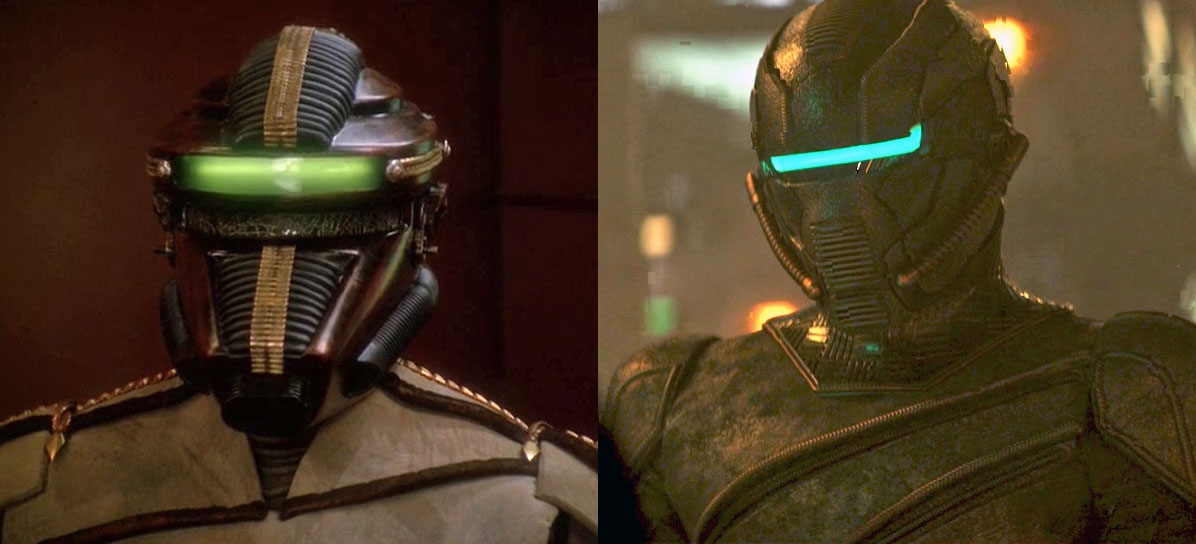
- During his time in command of Discovery , Rayner never sits in the captain’s chair.
- This episode closes with a dedication plaque that reads “In loving memory of our friend, Allan ‘Red’ Marceta”. Marceta was, I presume, the namesake for Discovery’s bar.
- Someone aboard Discovery keeps a Cardassian vole as a pet. Going by Tilly’s reaction, and what we know from Deep Space Nine , this is not a good thing.
- Linus (David Benjamin Tomlinson) plays a mean piano.
- Owosekun and Detmer get the off-screen cherry assignment of flying the ISS Enterprise back to Federation Headquarters, alone. I’m thinking that’s going to inspire some fanfic…

We don’t learn what this week’s clue is, though we know there’s a blue vial tucked away inside it, but we do learn that the crew of the ISS Enterprise did indeed make it to our universe. The scientist responsible for hiding this particular clue there was one of them, a Dr. Cho, who eventually made it all the way to branch admiral.
They strove for something positive and succeeded against all odds. Hopefully Discovery will be able to do the same as they continue their pursuit of Moll, L’ak, and the Progenitors.
Star Trek: Discovery Season 5 returns with “Whistlespeak” on Thursday, May 2.
- DSC Season 5
- Star Trek: Discovery
Related Stories
New star trek: discovery photos — “mirrors”, interview — sonequa martin-green on burnham’s “face the strange” encounter, star trek: discovery review — “face the strange”, search news archives, new & upcoming releases, featured stories, lost-for-decades original star trek uss enterprise model returned to roddenberry family, star trek: lower decks cancelled; strange new worlds renewed for season 4, our star trek: discovery season 5 spoiler-free review.
TrekCore.com is not endorsed, sponsored or affiliated with Paramount, CBS Studios, or the Star Trek franchise. All Star Trek images, trademarks and logos are owned by CBS Studios Inc. and/or Paramount. All original TrekCore.com content and the WeeklyTrek podcast (c) 2024 Trapezoid Media, LLC. · Terms & Conditions

Why Warp Drives Are About To Get Better
"Warp speed, Mr. Sulu!" With these words, Captain Kirk of the Starship Enterprise prepared his ship for faster-than-light travel while inspiring a generation of aspiring physicists who watched Star Trek from their sofas.
So it's no surprise that in 1994, the theoretical physicist, Miguel Alcubierre, worked out how a warp drive might work in the real universe. The key feature of a warp drive is that it can propel a spaceship at superluminal speeds without the occupants experiencing huge acceleration.
Alcubierre's idea was to create a flat region of spacetime inside a highly distorted bubble of spacetime that moves across the universe. The passengers sit in the flat region where the acceleration is zero, while the bubble as a whole, travels at superluminal speed, or at least exceedingly high velocity.
The big question, of course, was whether the Alcubierre drive was physically possible. The answer turned out to be probably not, because it required negative energy, which is not allowed by our current understanding of physics, and unfeasibly large energy densities.
Bubble Physics
Nevertheless, Alcubierre's work inspired others to look for alternative warp drives that might be physically possible. In 2021, physicists worked out how to make a warp drive using positive energy, although with unfeasibly high energy density. Indeed, there is a whole class of warp drives.
But evaluating these models is hard because of the fiendishly difficult mathematics behind them. The mathematics involves two stages.
Having come up with a structure for spacetime that might allow warp speed, the first is to solve Einstein's field equations to determine the flux of energy and momentum. This flux is given by mathematical entities called stress-energy tensors.
Once these have been found, the second stage is to work out whether the stress-energy tensors are physically realistic. In other words, whether they violate the laws of physics or require impractical resources, like infinite energy density.
These calculations are so complex that physicists often revert to simple solutions that make the equations involved more manageable, such as assuming spherical symmetry. However, this inevitably ignores potentially interesting spacetimes with more complex geometries.
Now Christopher Helmerich at the University of Alabama in Huntsville and colleagues have developed a software package called Warp Factory, that takes on the mathematical heavy lifting. "Warp Factory is a specialized toolkit designed for analyzing spacetimes related to warp drives," say Helmerich and co.
They put it through its paces by characterizing the stress-energy tensors of a range of known warp drive geometries, such as Alcubierre's, and evaluating their physical plausibility.
None of these models are close to being anything other than mathematical curiosities but the Warp Factory provides new ways to understand them and leads to new insights into their nature. In particular, it allows physicists to study subluminal warp drives in more detail, which may turn out to be the ones of most interest.
"This comprehensive toolkit provides insightful visualizations in both 2D and 3D, offering a deeper understanding of metrics and their corresponding stress-energy tensors," say Helmerich and co.
Factory Download
The team have made the Warp Factory available for download so anybody can study their design for a revolutionary warp drive. That's no guarantee that physically plausible warp drives will emerge. But it provides a tool that will surely kickstart research in this area. "We aim to further warp drive research and hopefully bring us closer to realizing physically achievable warp drives," say the researchers.
So don't be surprised if more plausible warp drives emerge in the coming weeks and months. Indeed, Helmerich and co hint at as much in their paper. "In a separate paper, currently in preparation, a new constant velocity warp drive solution has been found without energy condition violations," they say. Just how physically plausible this will be, is not yet clear.
Nevertheless, Mr. Sulu would surely be impressed.
Ref: Analyzing Warp Drive Spacetimes with Warp Factory : arxiv.org/abs/2404.03095


IMAGES
VIDEO
COMMENTS
Of the original Constitution-class warp core, only the dilithium crystal converter assembly and the warp engine plasma conduits were ever seen in Star Trek: The Original Series.The first season had a dilithium crystal energizer room only seen in "The Alternative Factor".It is likely the predecessor to the dilithium crystal converter assembly added to Main Engineering in seasons two and three.
Of the original Constitution-class warp core, only the dilithium crystal assembly and the plasma conduits were ever seen in Star Trek: The Original Series. When Doug Drexler was called to design the detailed schematics of a Constitution-class starship, he designed a horizontal warp core that runs two decks below main engineering.
Aug 8, 2010. Donovan Loucks said: ↑. In TNG (and possibly as early as ST:TMP) the warp core provided the energy necessary to create the warp fields generated by the warp nacelles. However, the warp core was not actually located within the warp nacelles themselves. instead, the warp core stretched from the secondary hull through the dorsal ...
Star Trek Iconic Sounds. ... VOY Warp Core 1 VOY Warp Core 2 VOY Warp Core 3 VOY Warp Core 4 . Forcefield Disable *NEW* Forcefield Hit Forcefield On 1 Forcefield On 2 ... TOS Warp Flyby 2 TNG Slow Warp 1 TNG Slow Warp 2 TNG Warp Exit TNG Warp Flash TNG Warp 1 TNG Warp 2 TNG Warp 3
I don't think we ever actually see the warp core for the old TOS Enterprise, we usually just saw a room with some computers and a red glow behind a vent opening, so I don't think it's technically breaking canon - not that it matters, really, Star Trek shouldn't be constrained by 60s/80s/90s ideas of future technology.
ADMIN MOD. The SNW and TOS Enterprise main engineering. Looking at schematics, sets and set plans, it seems reasonable that the warp core of the SNW-Enterprise is in the engineering section, directly below the aft part of the saucer section, inside the one big room known as "main engineering", which contains also the inside of the main ...
For TOS Engineering, I am taking a cue from Star Trek II and placing some things to the side so the classic engineering room is going to be just one half of a larger complex that sits right over the main Warp Core. For my main sources I am relying on the original TOS cross section that Matt Jefferies made.
The First Unambiguous Warp Core. The First Unambiguous Warp Core is in Star Trek: The Motion Picture. Although Part C - the FWACKOOM! Chamber is subtle - the glowing lights and plasma conduits make it plain, especially in light of subsequent development of the franchise. Decker and Scotty discuss the spacing of the spark plugs.
A warp core breach, or warp drive containment breach, was a catastrophic failure of a starship's warp core. ... (TOS: "Space Seed") ... (Star Trek Generations) However, Geordi La Forge eventually rebuilt the vessel by 2401, repairing the damage to the saucer section over the course of twenty years and replacing the engineering hull with that of ...
Star Trek: Prodigy 's Angus Imrie ( Zero ) explains warp cores and warp drive. Star Trek: Prodigy Season 1 is available to stream on Netflix outside of markets including Canada where it is available on CTV.ca and the CTV App, France on France Televisions channels and Okoo, in Iceland on Sjonvarp Simans Premium, as well as on SkyShowtime in the ...
(Star Trek: The Original Series; ENT: "In a Mirror, Darkly, Part II") By 2270, most Federation warp cores were redesigned to consist of a large warp core unit in the secondary hull with matter and antimatter channeling into the core through vertical conduits, with the resulting energy directed to the nacelles through a horizontal conduit ...
The vertical warp core's first appearance was in Star Trek: The Motion Picture and was seen in all subsequent Star Trek productions set after TOS. As a safety precaution, the core can be physically ejected from the ship should an event such as the catastrophic failure of the containment of the matter-antimatter reaction occur and the crew ...
A warp drive or a drive enabling space warp is a fictional superluminal (faster than the speed of light) spacecraft propulsion system in many science fiction works, most notably Star Trek, and a subject of ongoing physics research. The general concept of "warp drive" was introduced by John W. Campbell in his 1957 novel Islands of Space and was popularized by the Star Trek series.
Warp and Singularity Cores are a type of starship equipment which was added to the game with Legacy of Romulus. They determine the maximum warp speed in sector space and primarily increase the available power for certain subsystems. A warp core is the power generator for starships. The most common type is an Matter Anti-Matter Warp Core that derives energy from the controlled reaction of ...
Warp core in TOS Enterprise. Discussion in 'Star Trek - The Original & Animated Series' started by Josh_Lyman, Aug 5, 2008. Page ... Joined: Oct 22, 2004 Location: Upper Mississippi River. You'll drive yourself crazy reverse enginnering Star Trek, Josh. Things that were common in the later series were less so in Star Trek, if not missing ...
Inside a warp core, matter and antimatter are allowed to contact and annihilate each other within a magnetic containment field. Dilithium crystals are used to control the reaction, and their orientation affects the efficiency of the reaction. [1] Energy from the reaction is collected in the form of plasma and piped around the ship through ...
Etymology []. The USS Discovery at warp in 2257. The USS Stargazer performs a warp jump. In 2063, the term "warp drive" was already used by Zefram Cochrane of his engine on the Phoenix.However, Cochrane used the term "space warp generator" in the monitor displays on his spacecraft. (Star Trek: First Contact) Even as late as the 2150s, the warp five engine was still officially known as a ...
On shows like Star Trek: The Next Generation, we frequently see characters like Chief Engineer Geordi LaForge frantically working to keep the ship from experiencing a warp core breach. And while ...
Enjoy your off-duty time by relaxing with three hours of the soothing sound of the Enterprise-D's warp core.Stream full episodes of Star Trek: The Next Gener...
Subspace. In the Star Trek fictional universe, subspace is a feature of space-time that facilitates faster-than-light transit, in the form of interstellar travel or the transmission of information. Faster-than-light warp drive travel via subspace obeys different laws of physics. The name "subspace" has also been adopted and used in other fictional settings, such as the Stargate franchise, The ...
The USS Enterprise (NCC-1701-D) was a Federation Galaxy-class starship operated by Starfleet, and the fifth Federation vessel to bear the name. The Enterprise served from 2363 to 2371 as the Federation flagship, under the command of Captain Jean-Luc Picard. Following the ship's destruction at Veridian III, it was rebuilt as a museum ship, and was briefly brought back into service to counter a ...
The Overcharged Warp Core is a type of Warp Core that increases the maximum capacity of a ship's Auxiliary Power setting. The Overcharged Warp Core increases a ship's maximum Auxiliary Power setting by +5, allowing a maximum of 130 to Auxiliary. Warp Cores can be acquired either as drops in combat, through Duty Officer Assignments, on the Exchange, or from Fleet Vendors.
A 30 foot boat with a Mercury 150 horsepower engine uses 15 gallons of fuel per hour. An Arleigh burke destroyer uses 1000-2000 gallons of fuel per hour. A ships warp core runs whether it's traveling at warp or not. So assuming 8 grams is sufficient for casual warp velocity (warp 5), Warp 6 uses more, and so on.
STAR TREK: DISCOVERY Review — "Mirrors". "Mirrors" is an episode whose parts are unfortunately greater than their whole: three stories that each needed to be told for the season to progress, but which all feel like a bit of an afterthought when combined together. Instead of loose threads woven into the tapestry of the season, they ...
The mathematics of warp drives is fiendishly difficult. Now a specialist software package is set to change the way physicists model Star Trek-like travel.